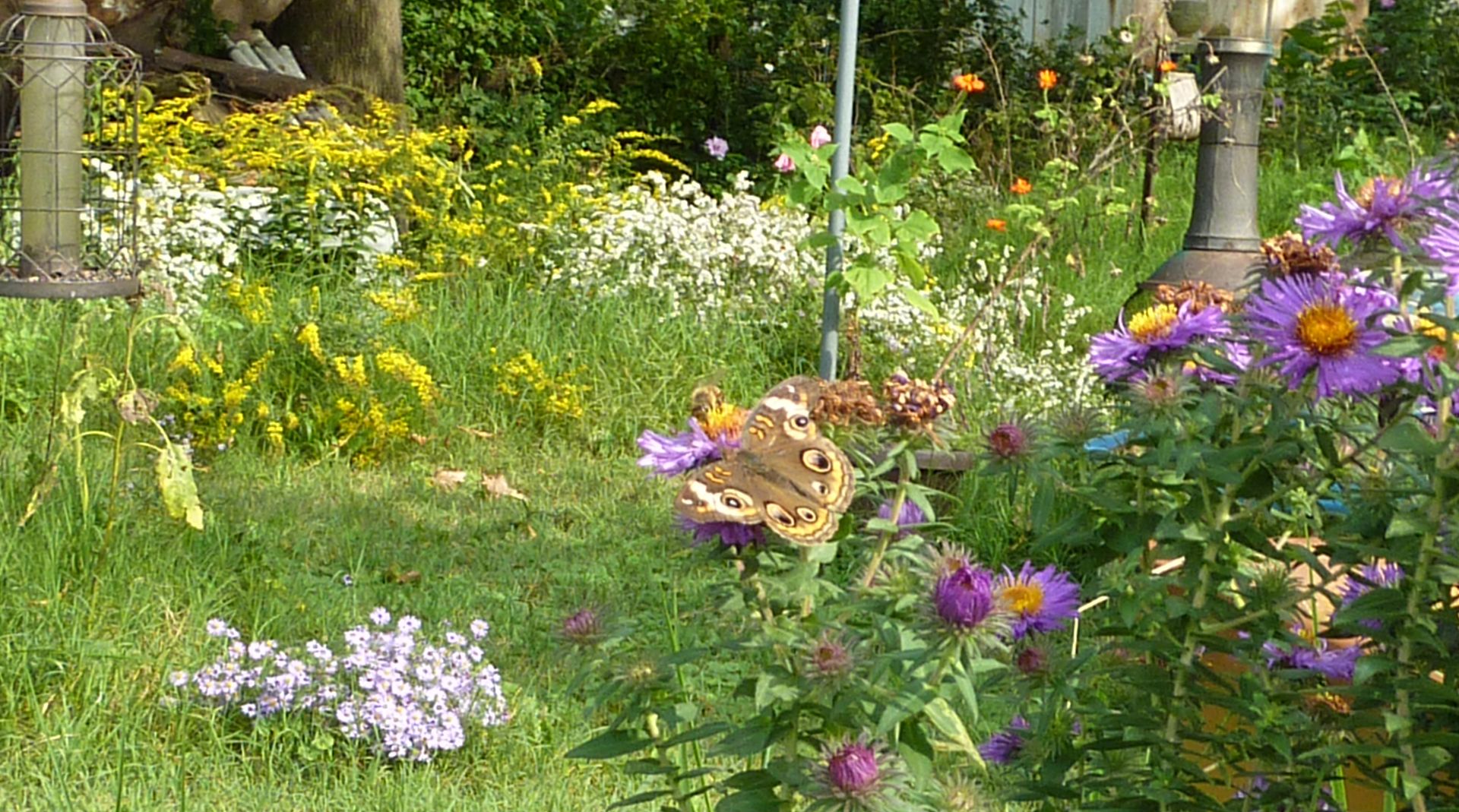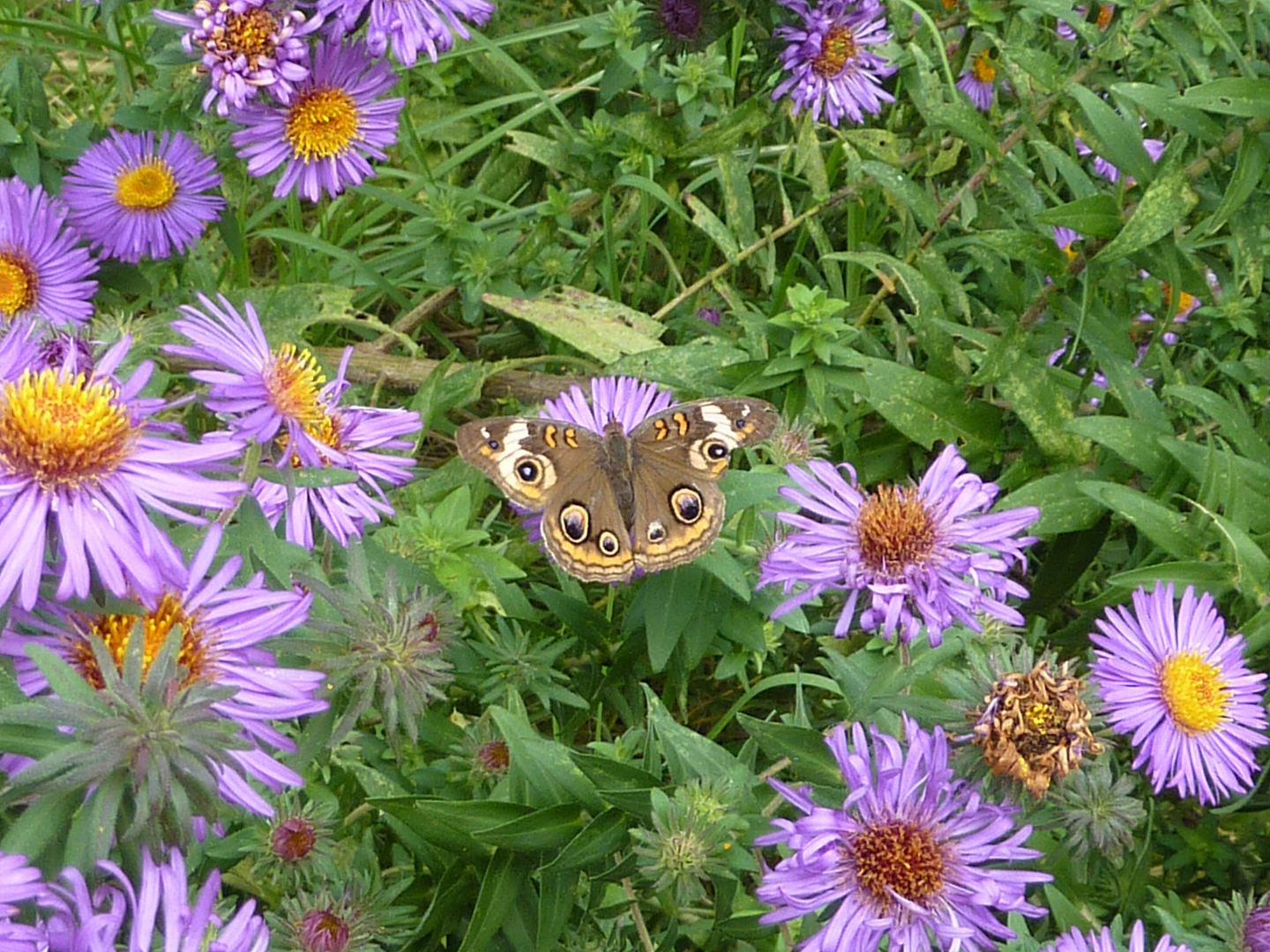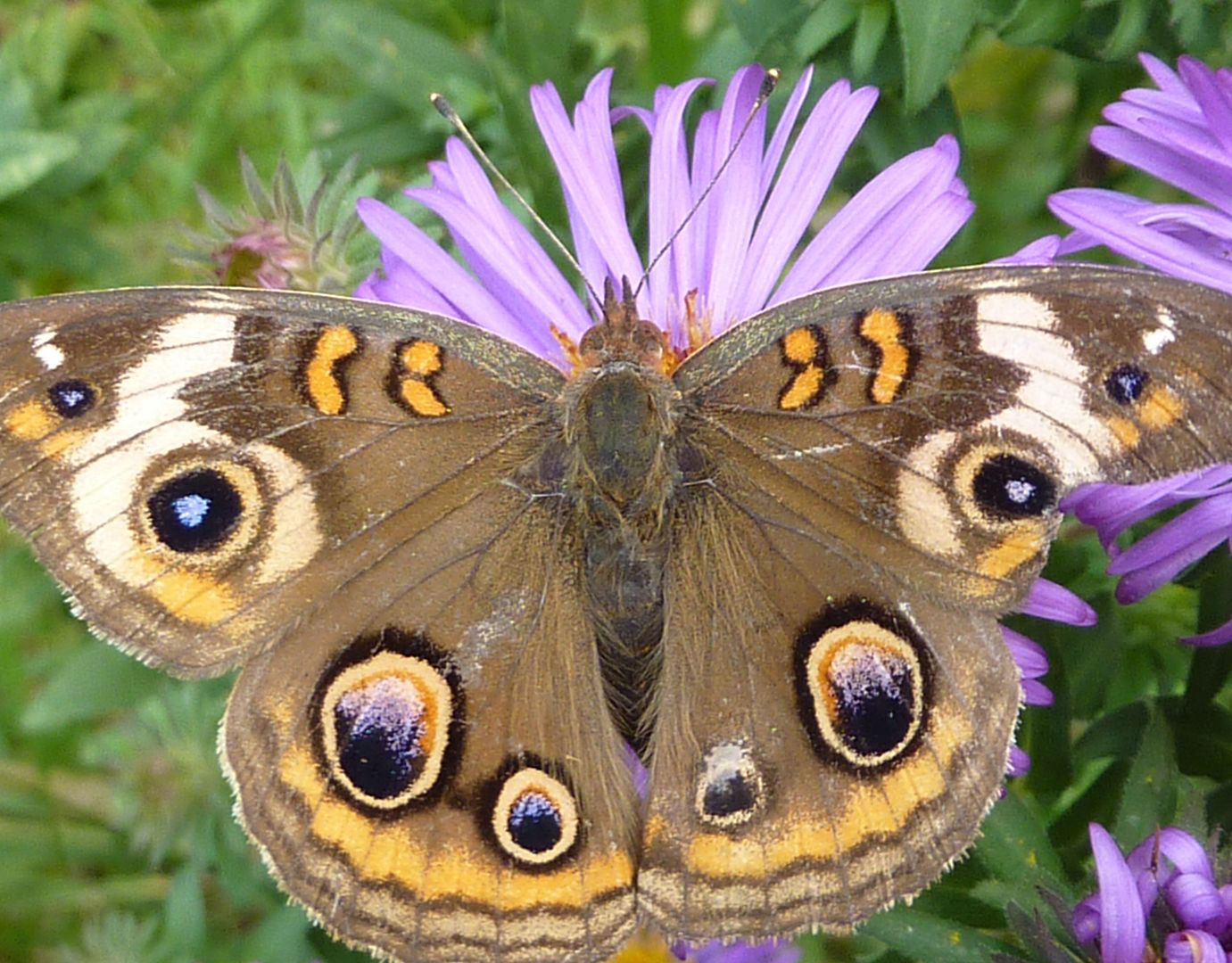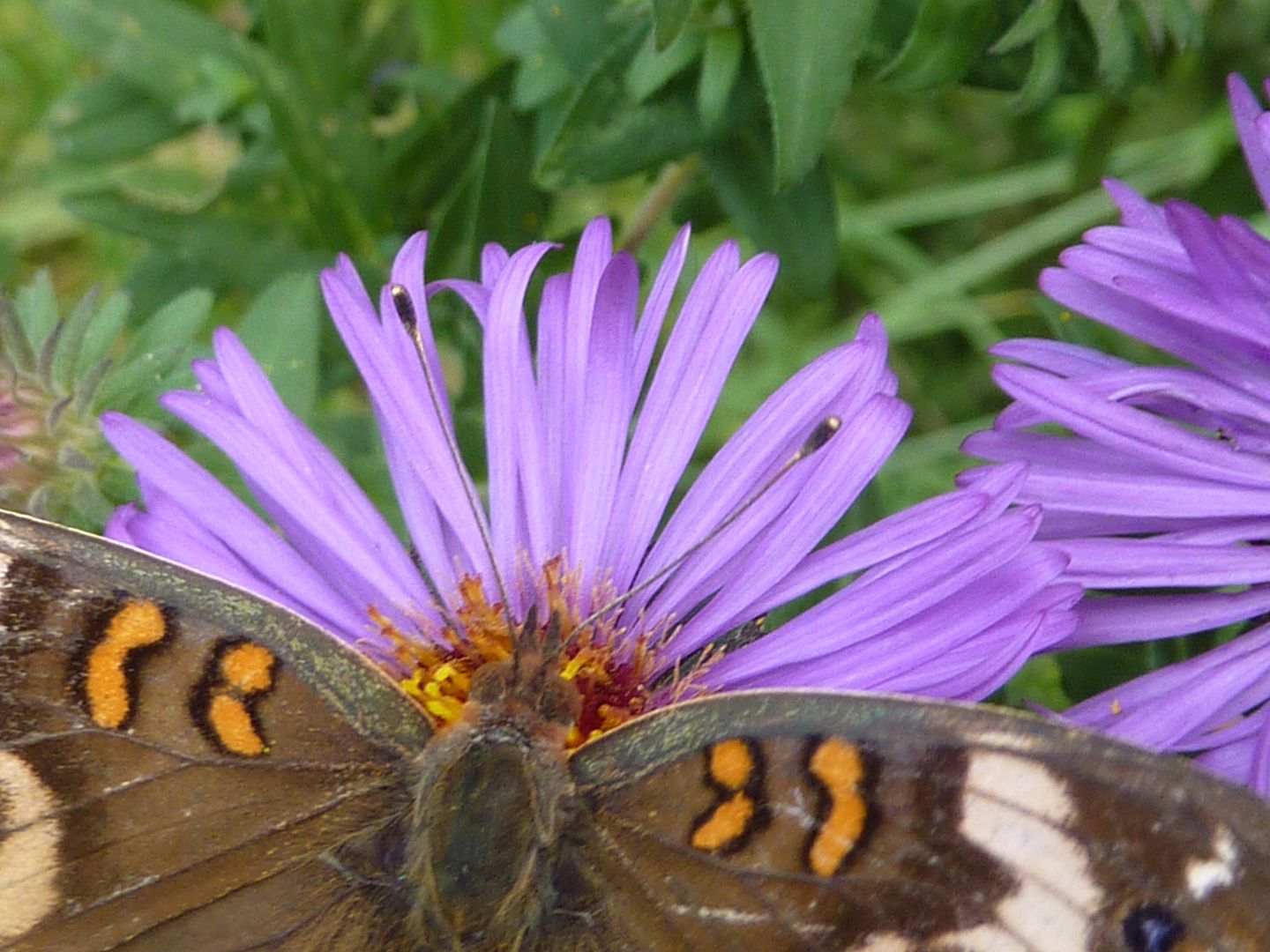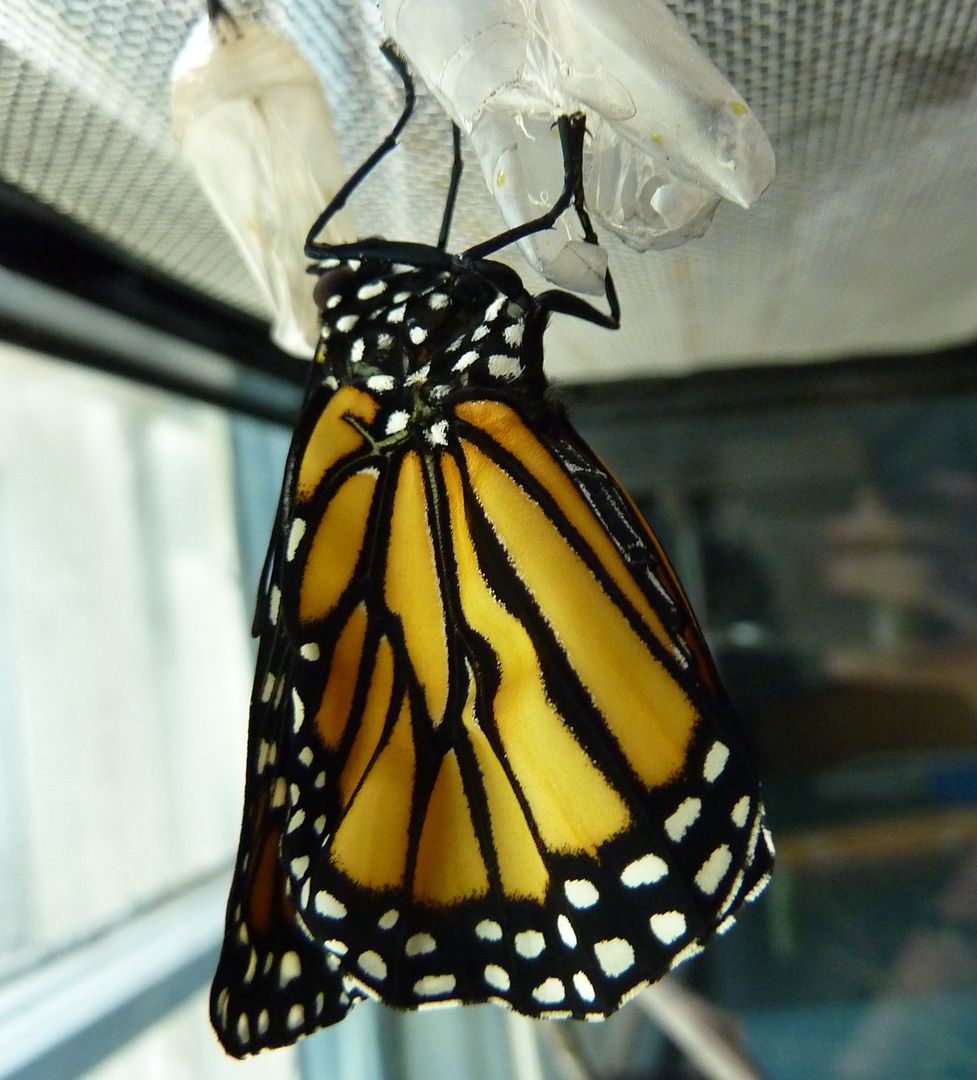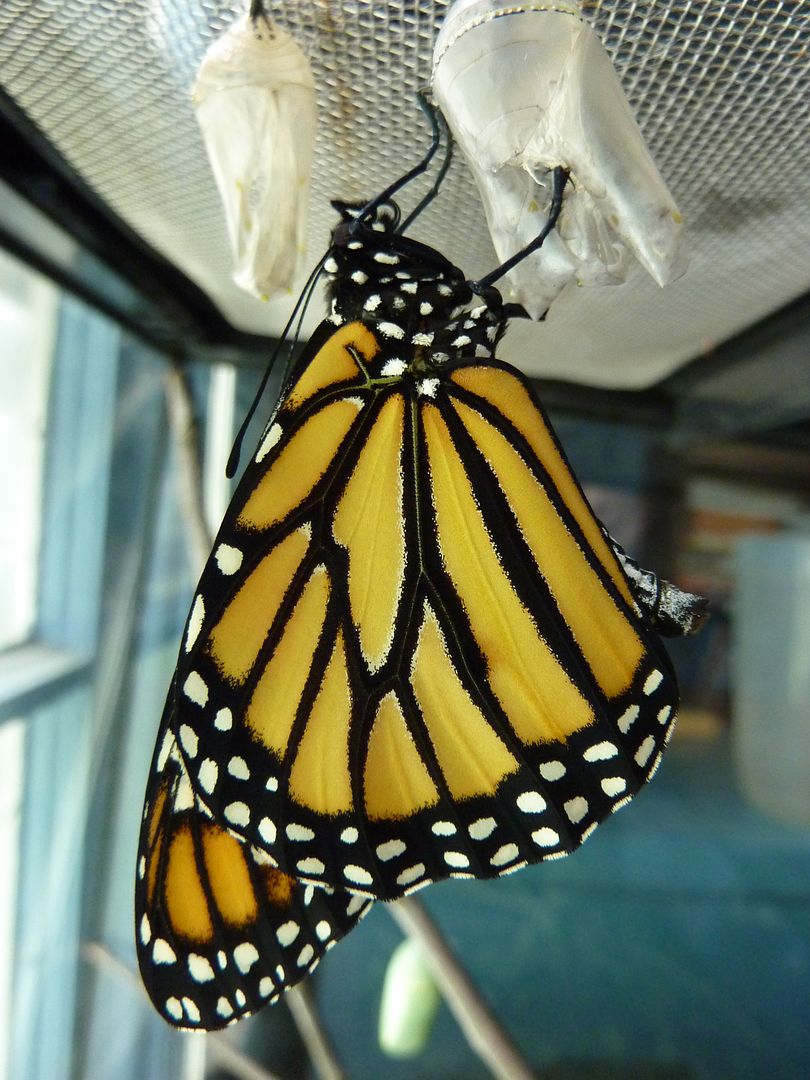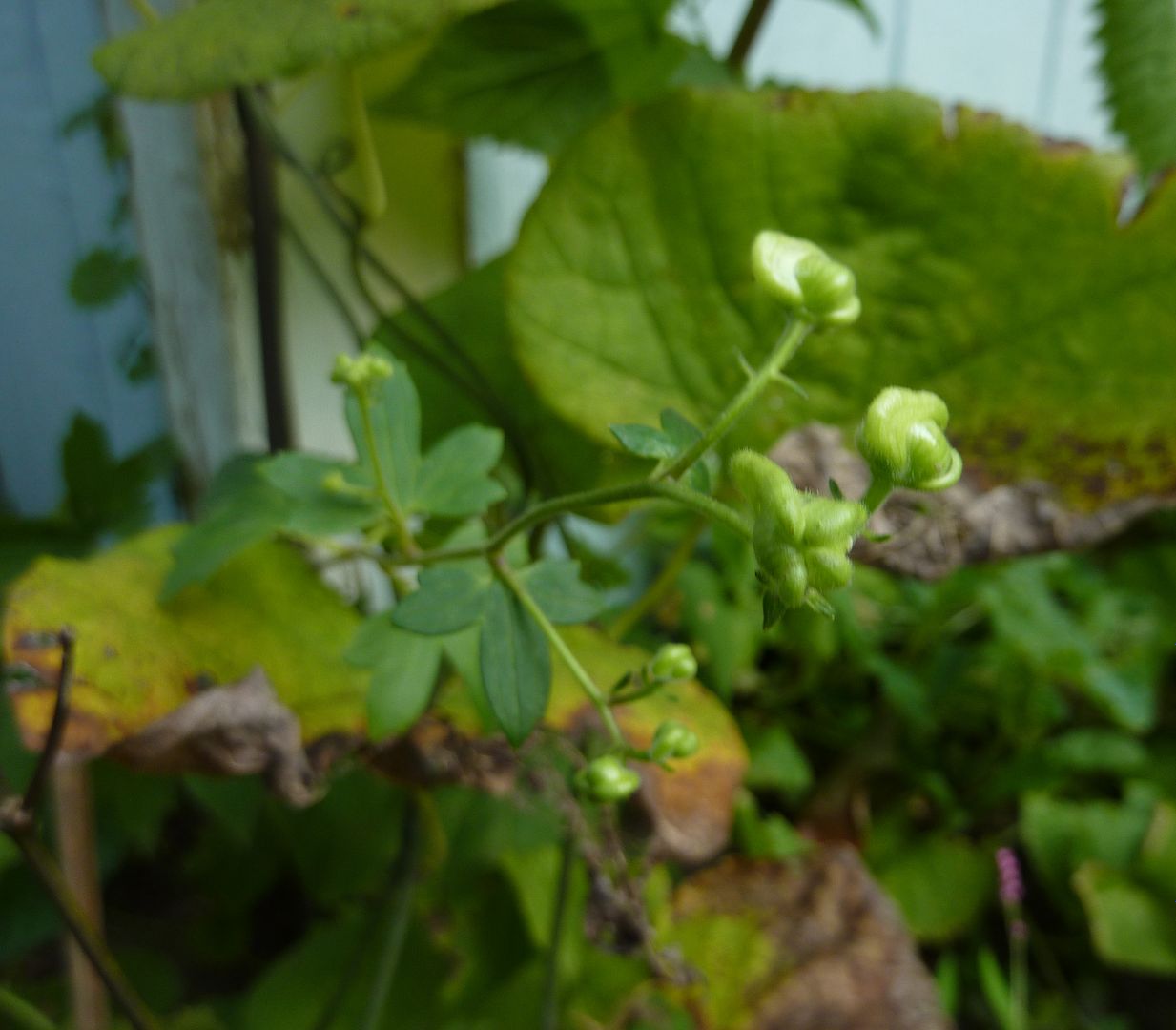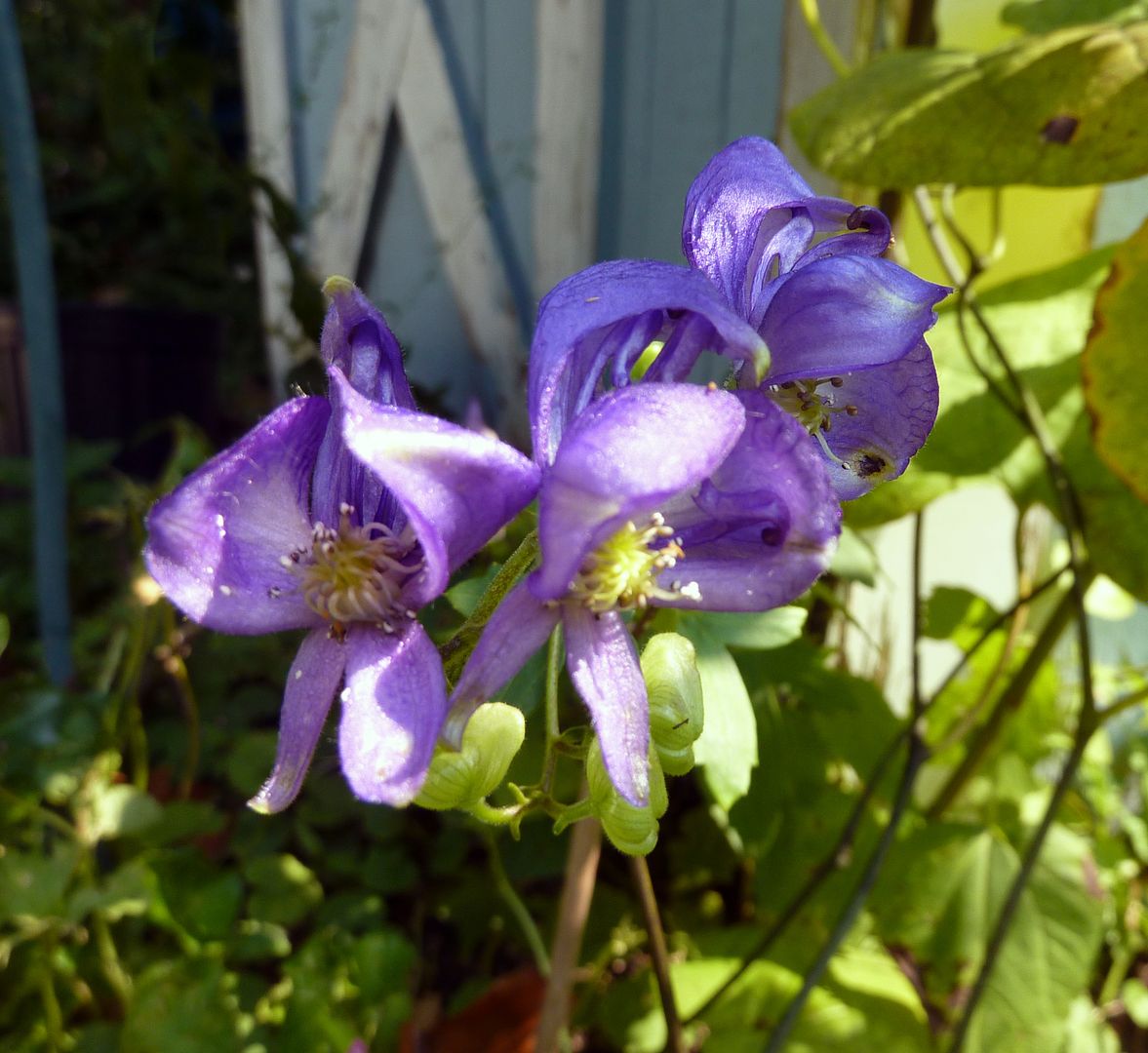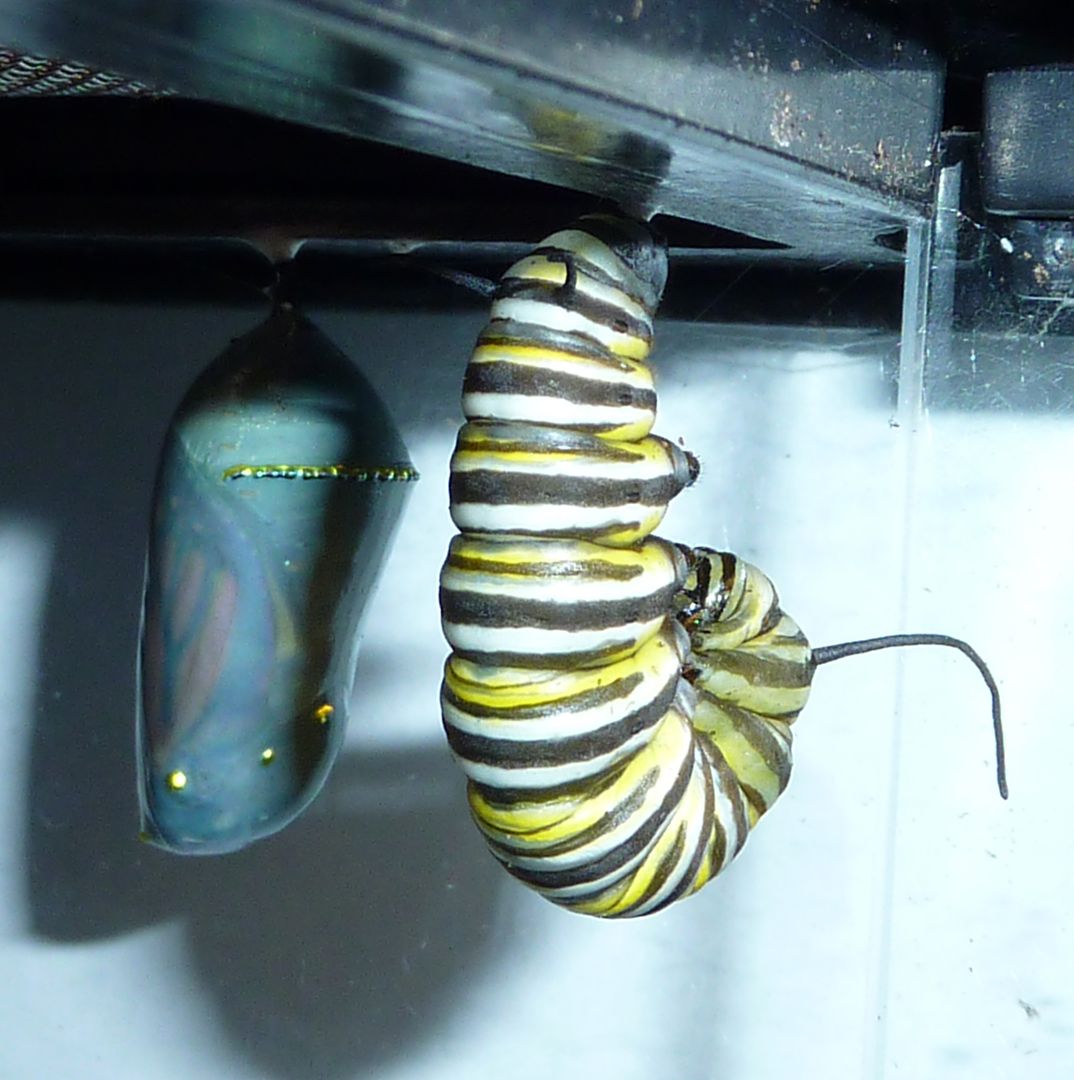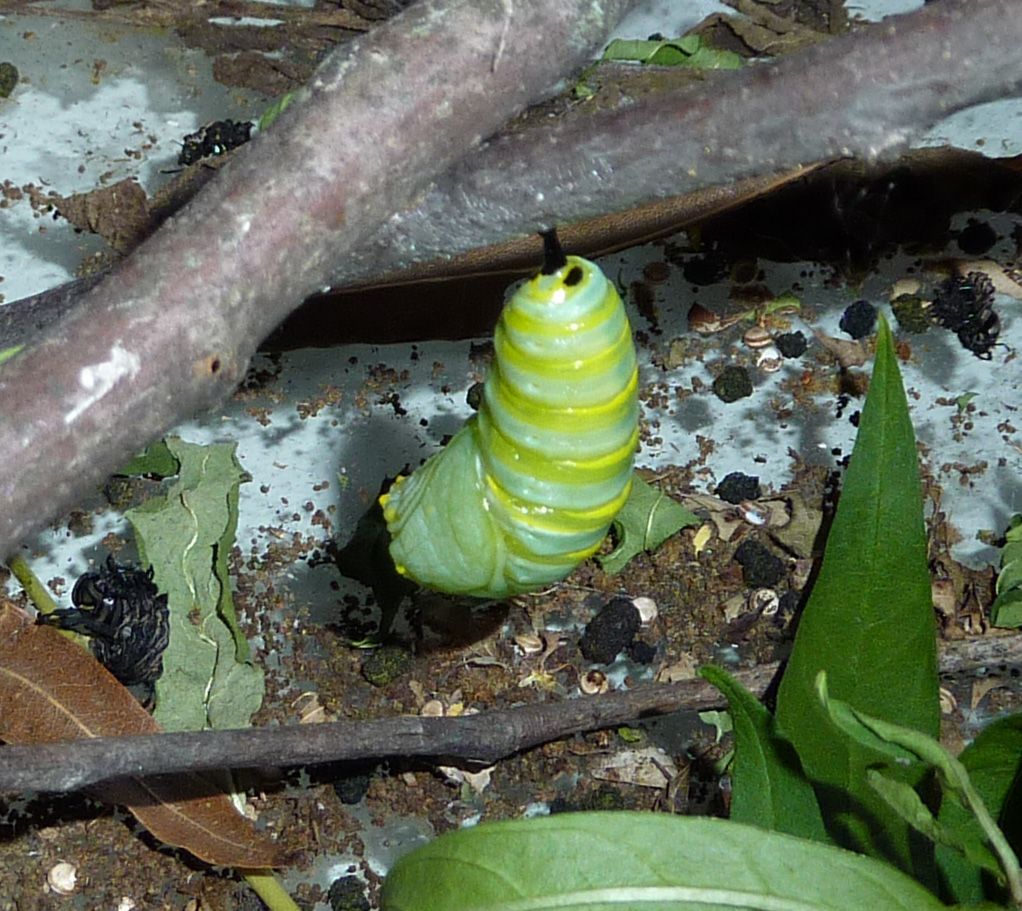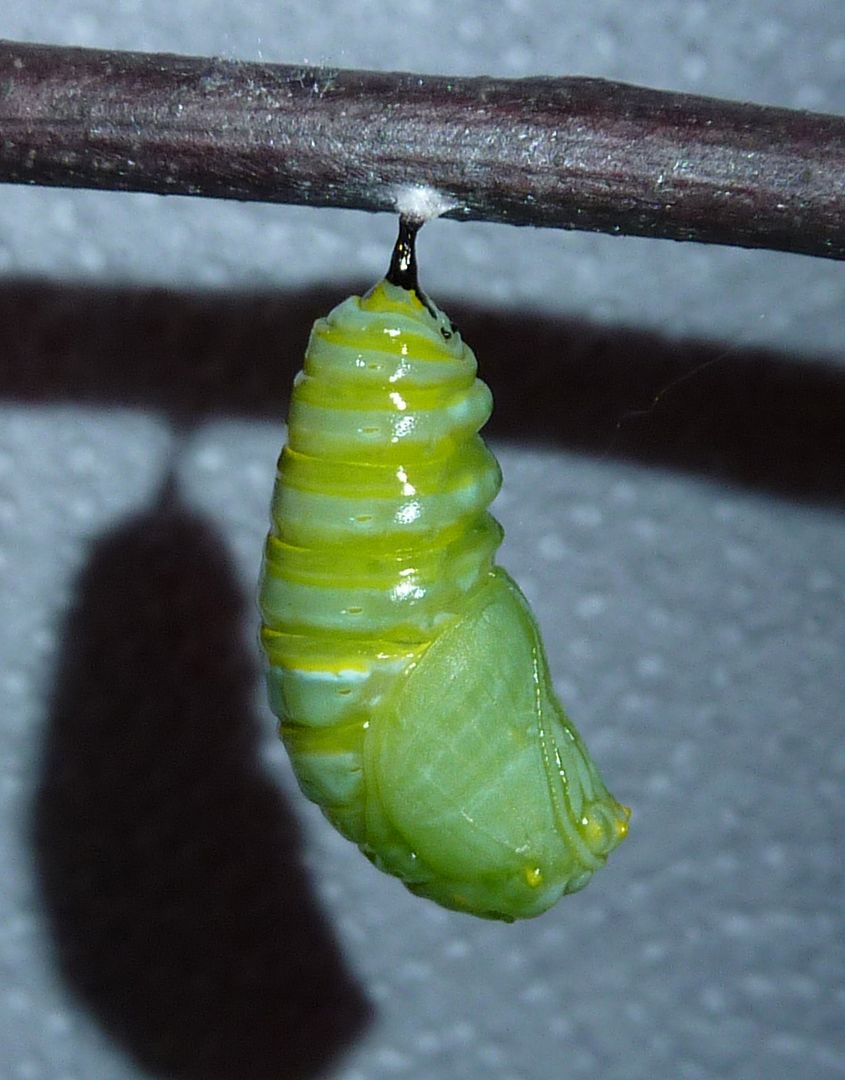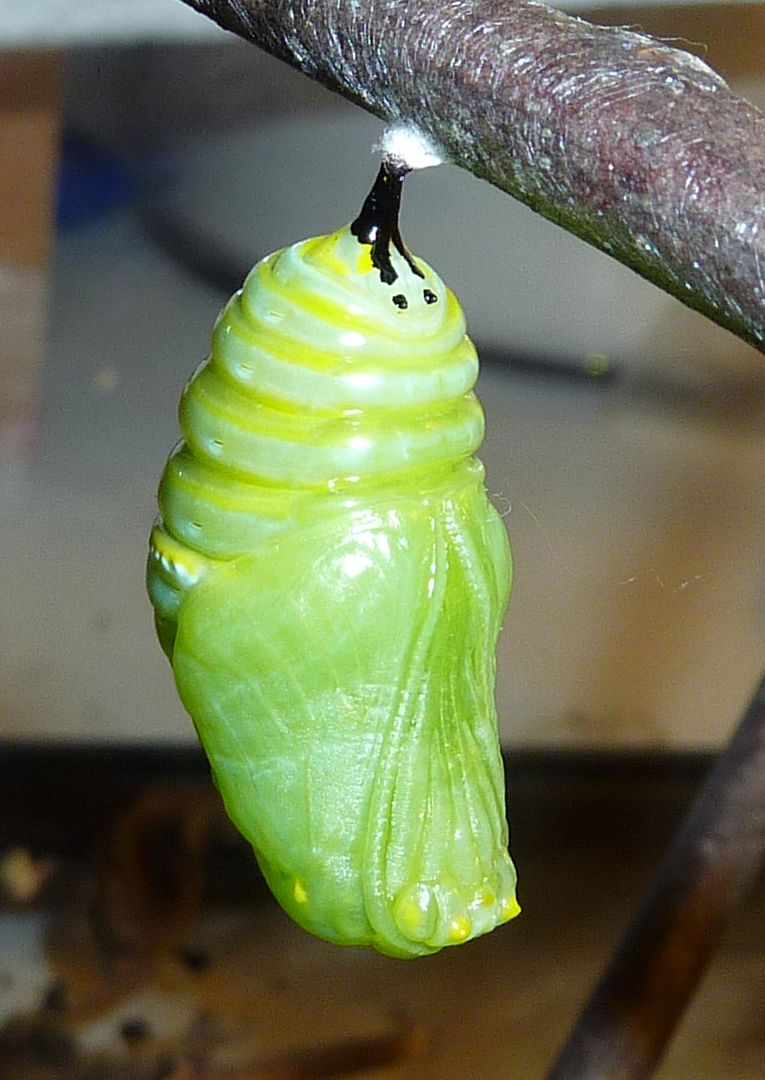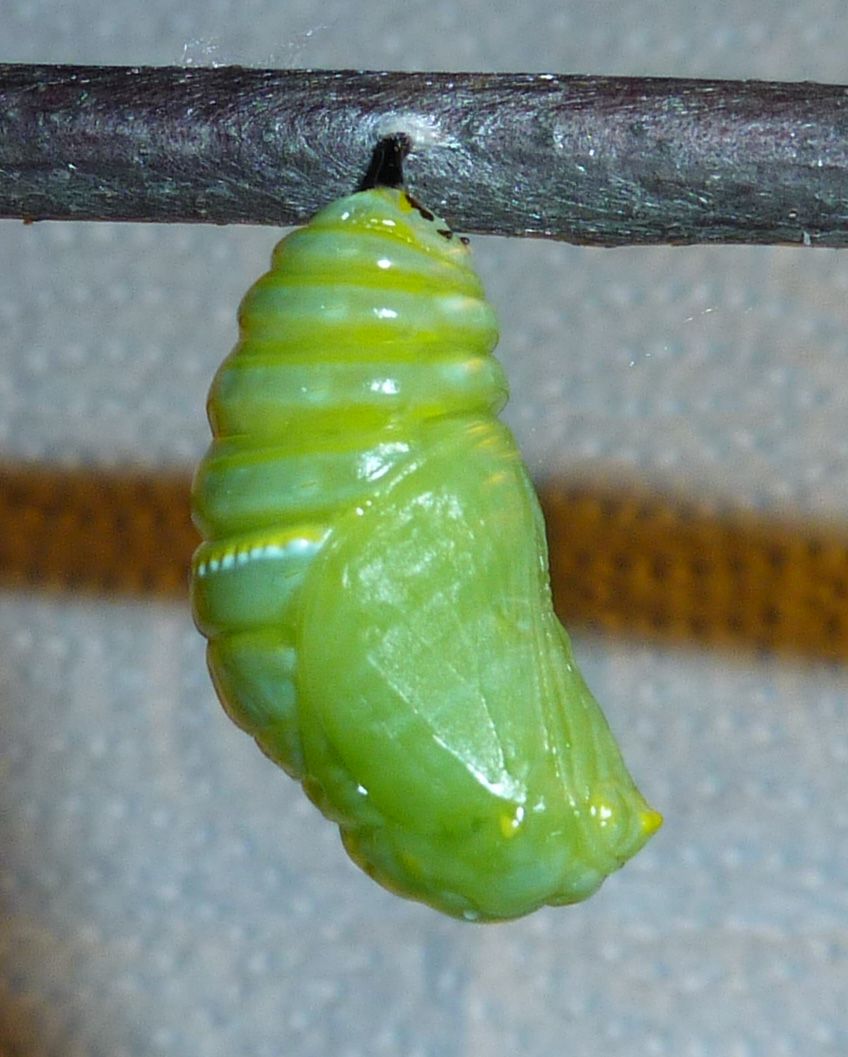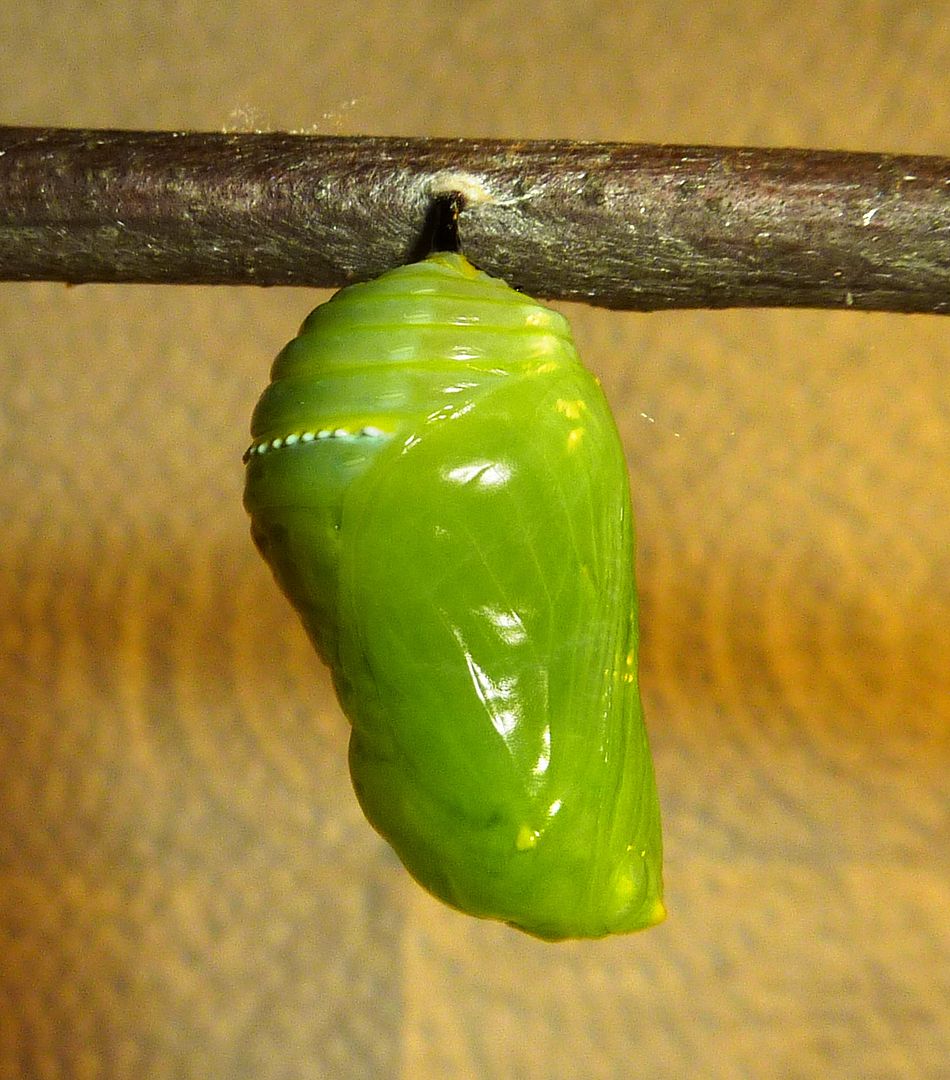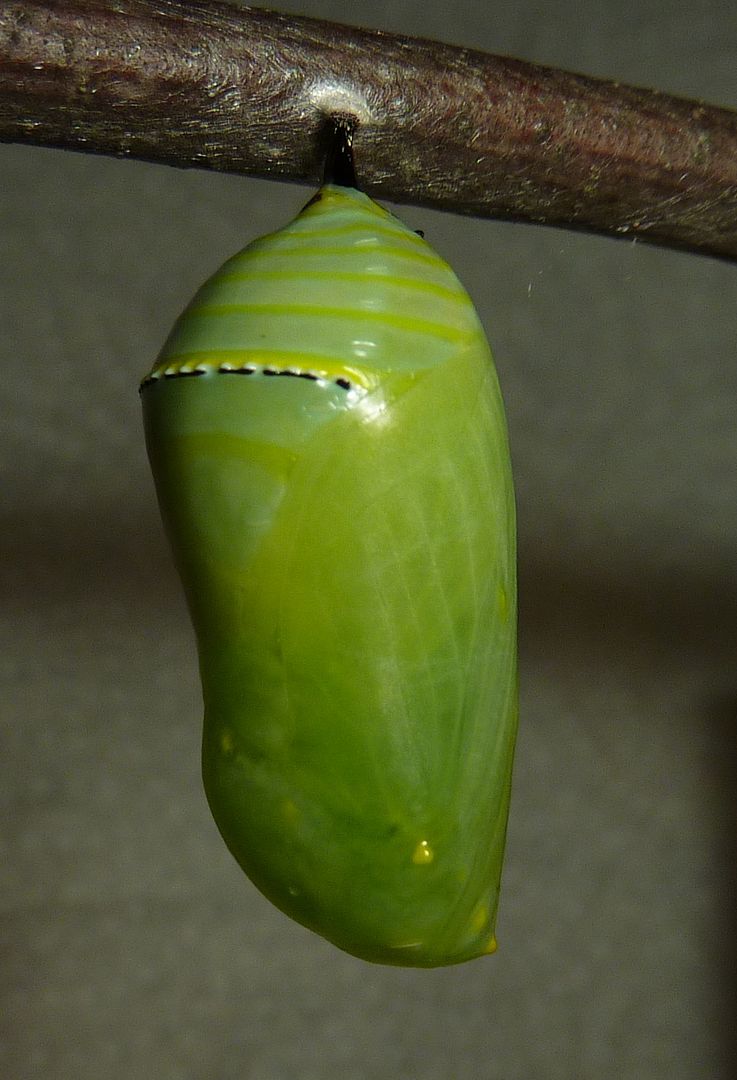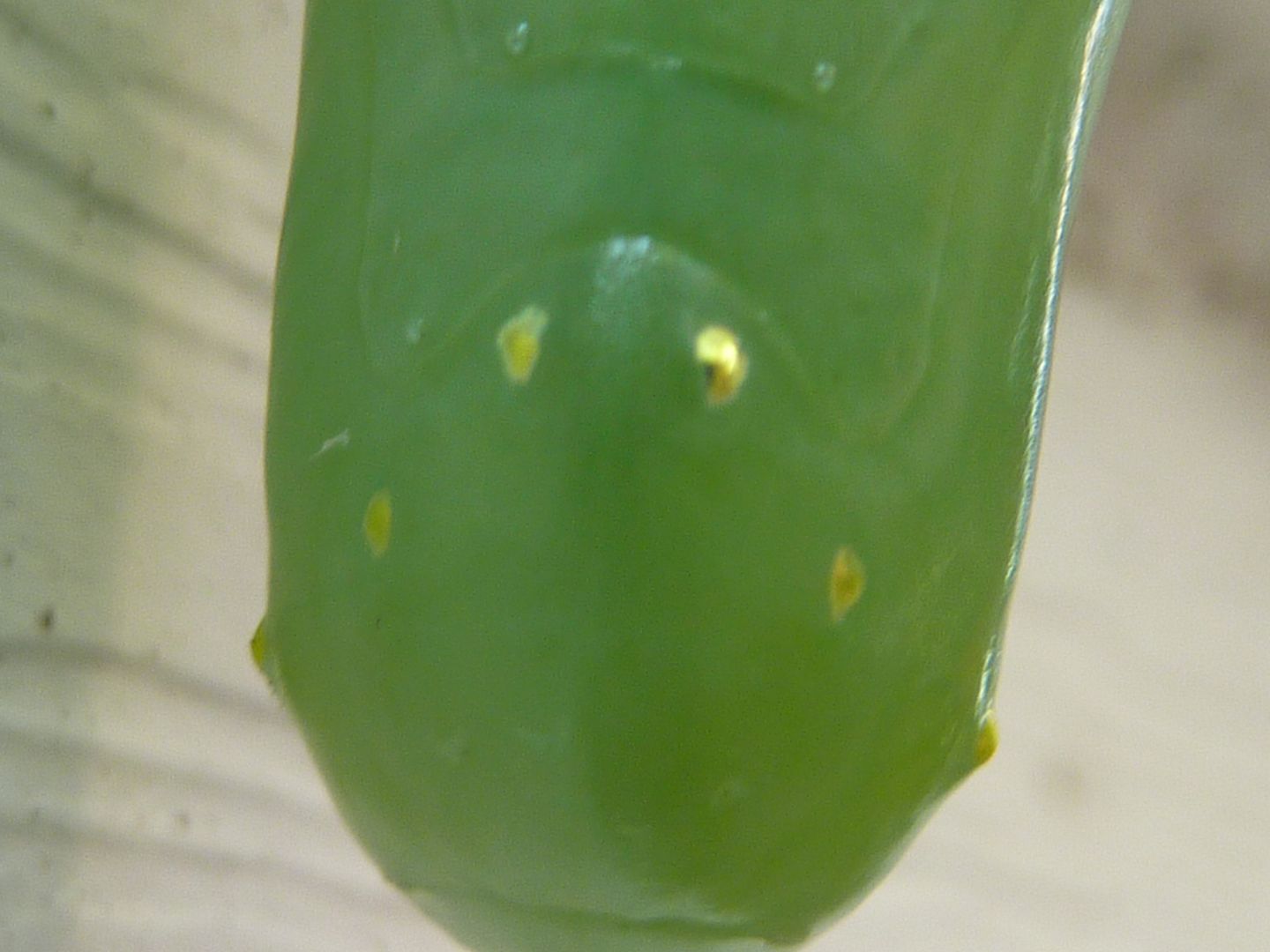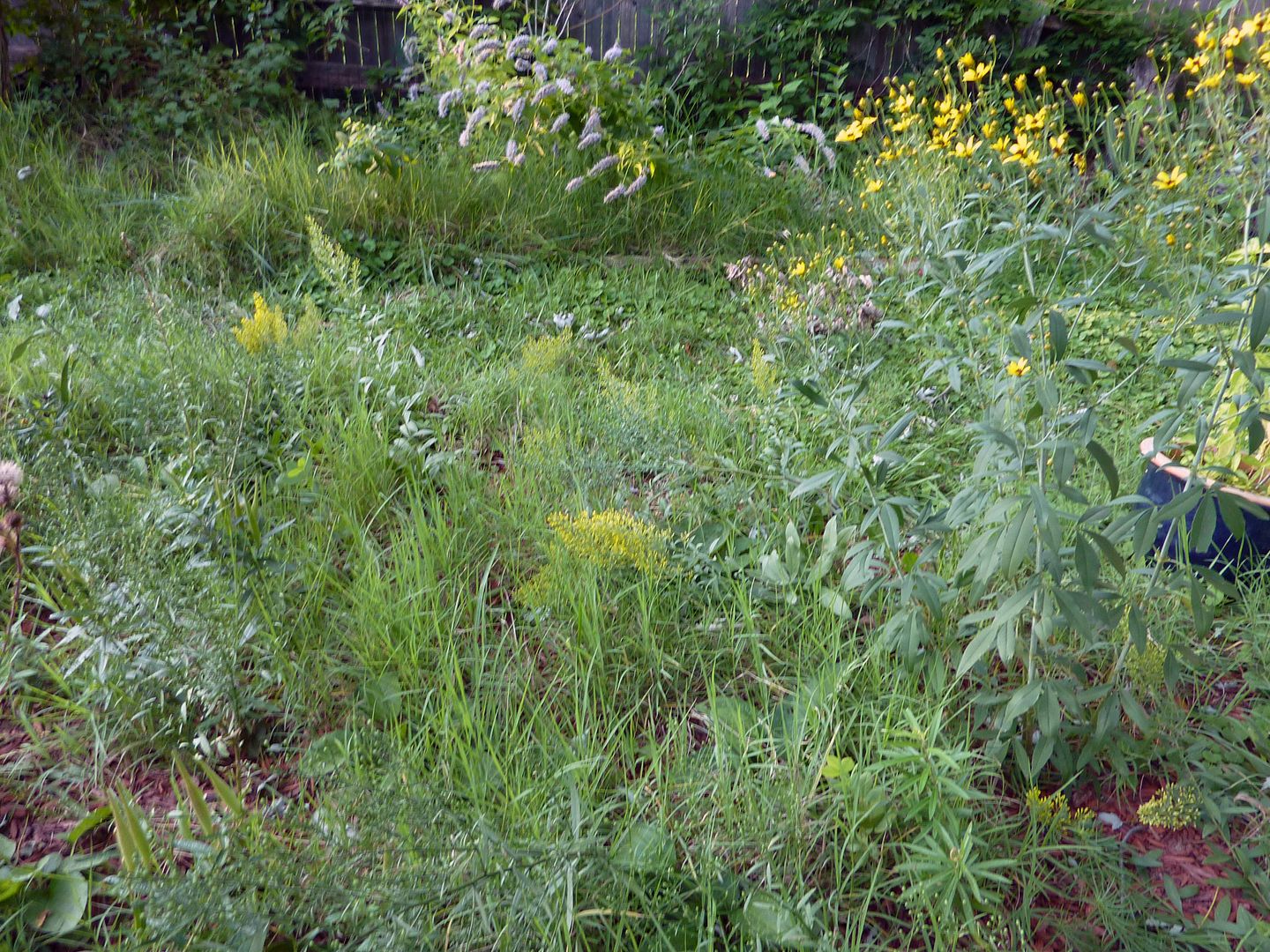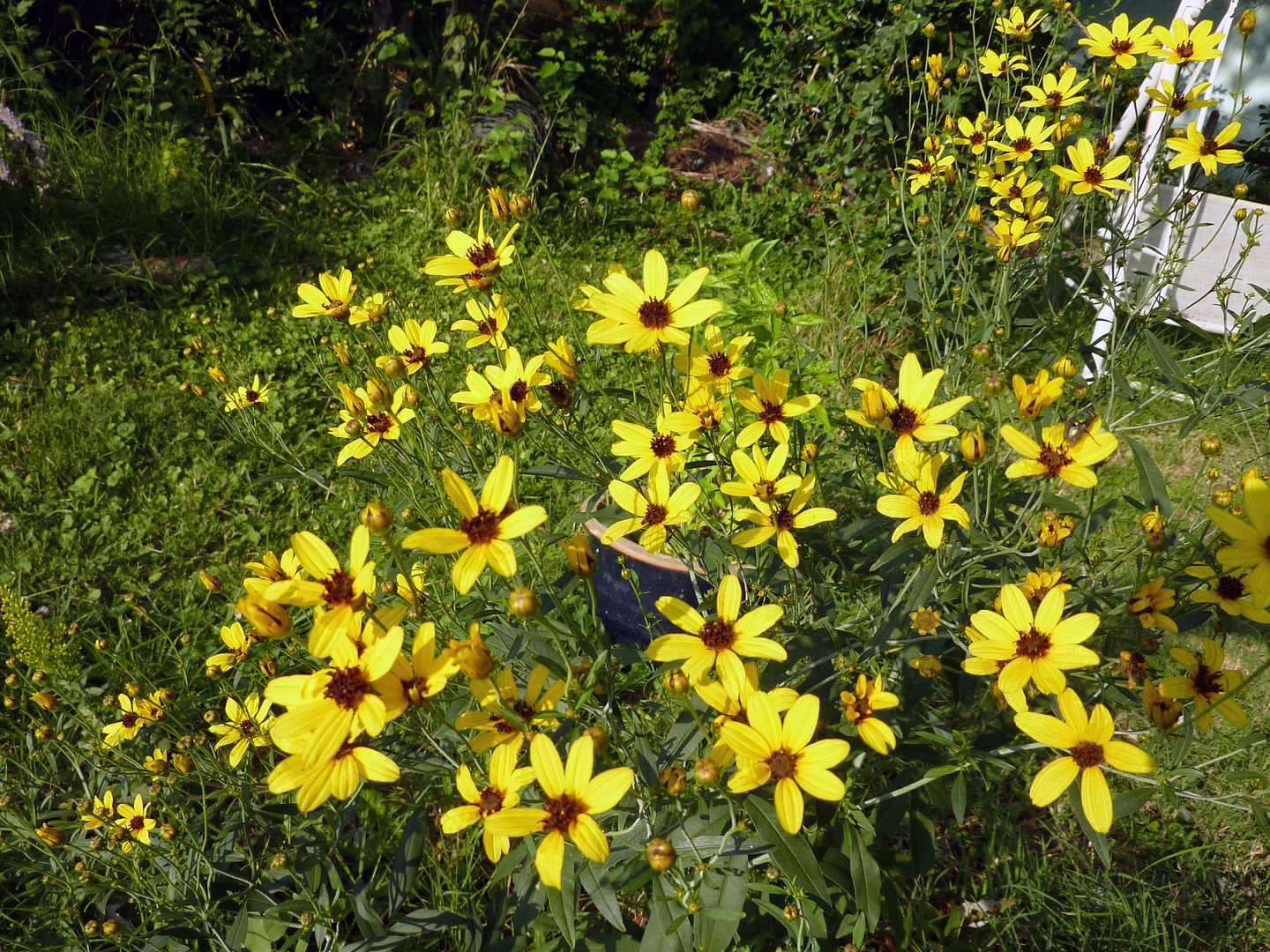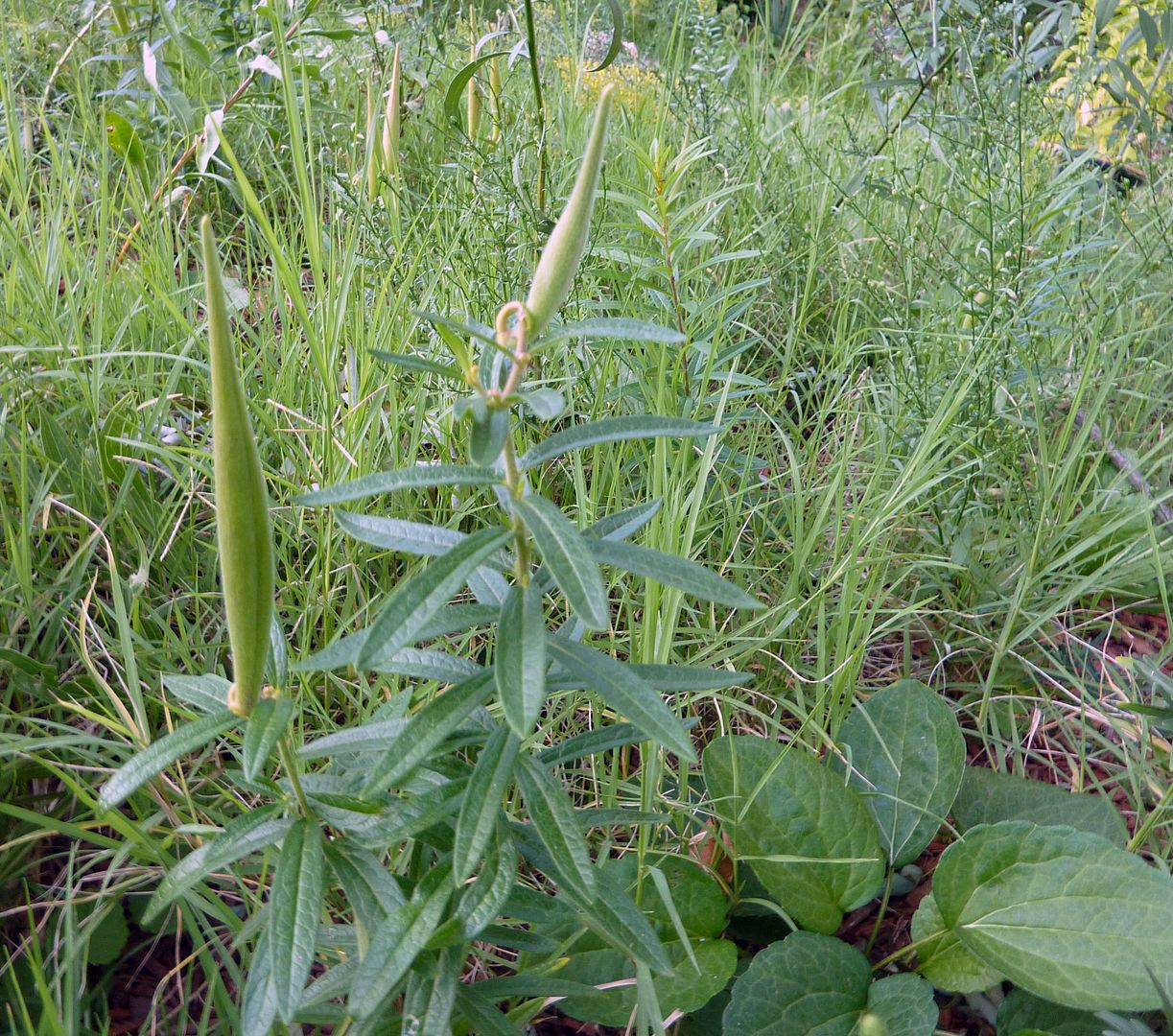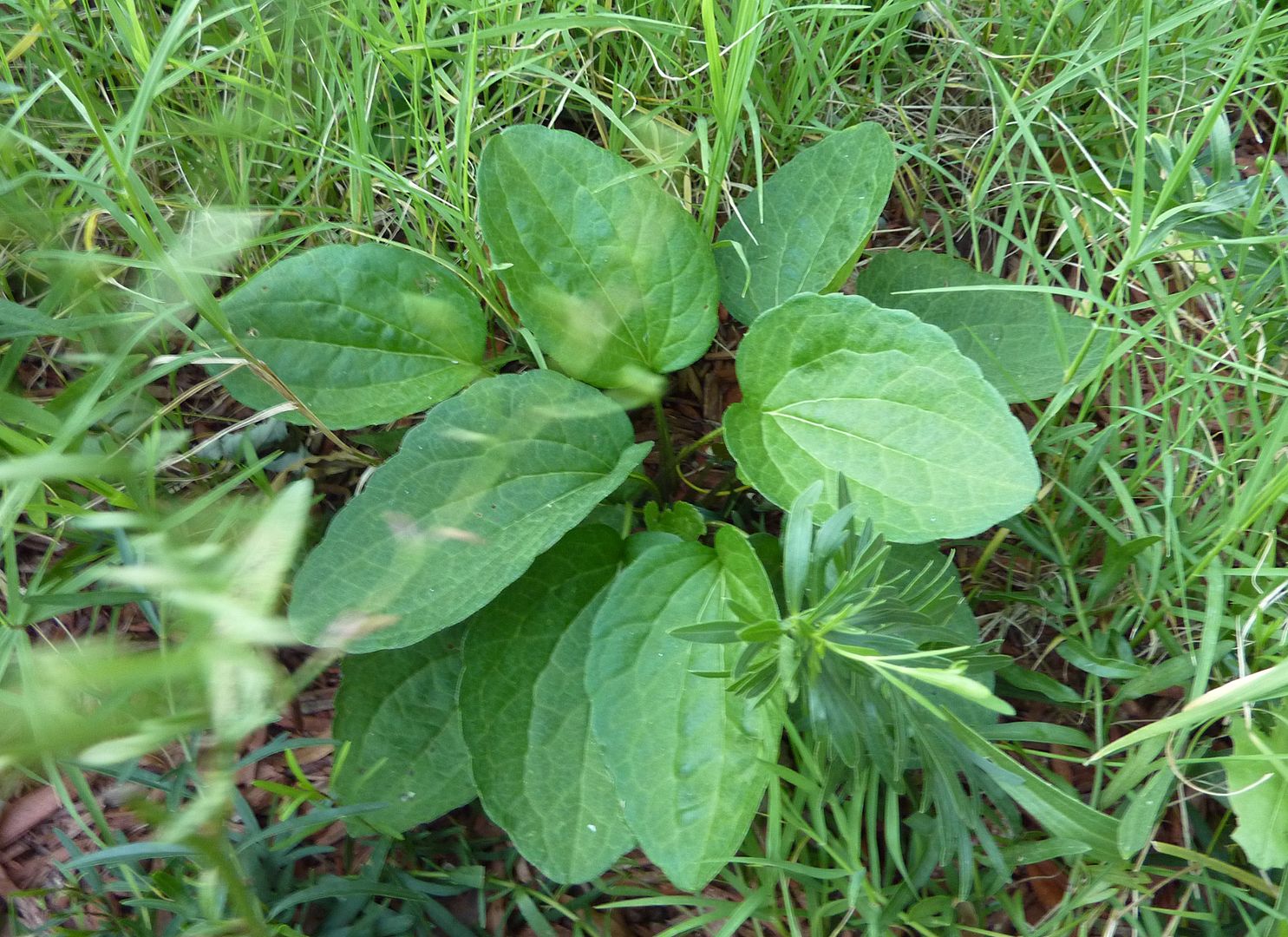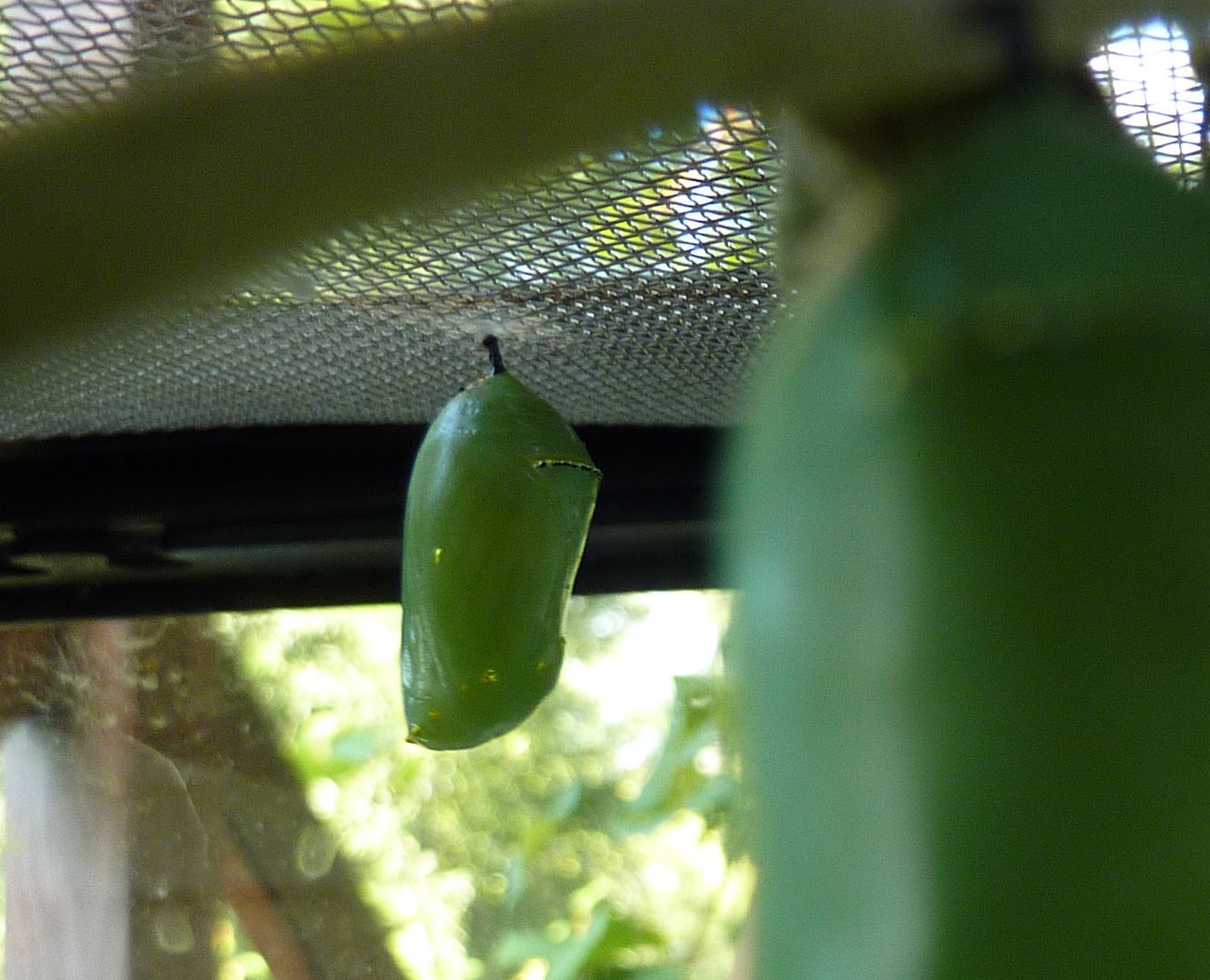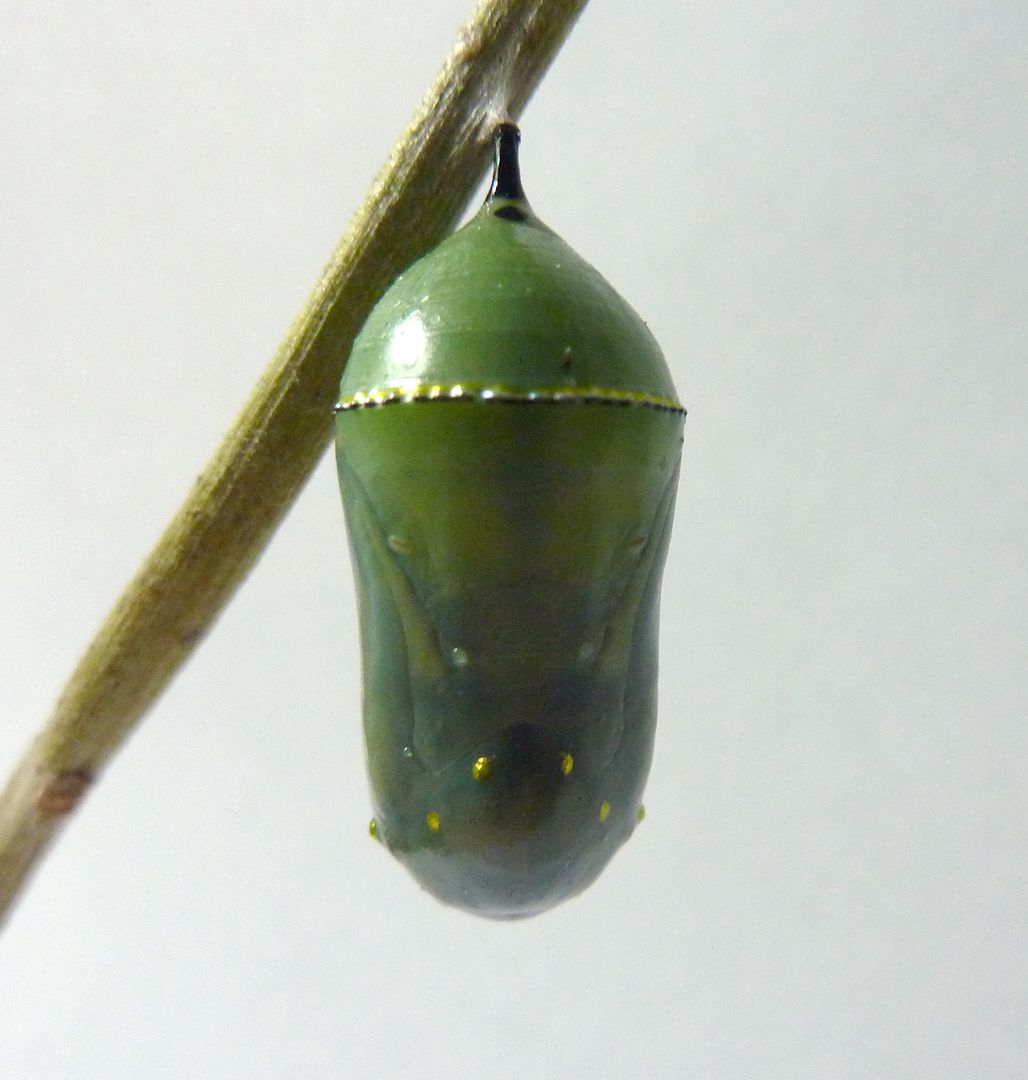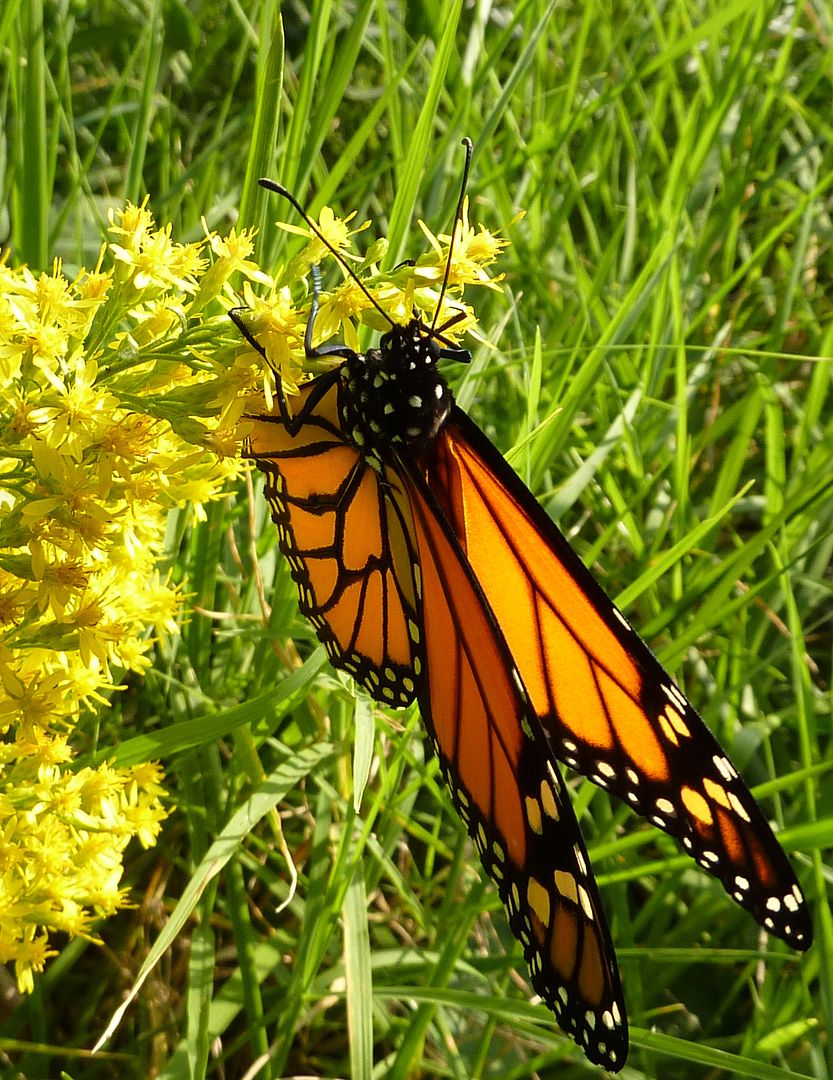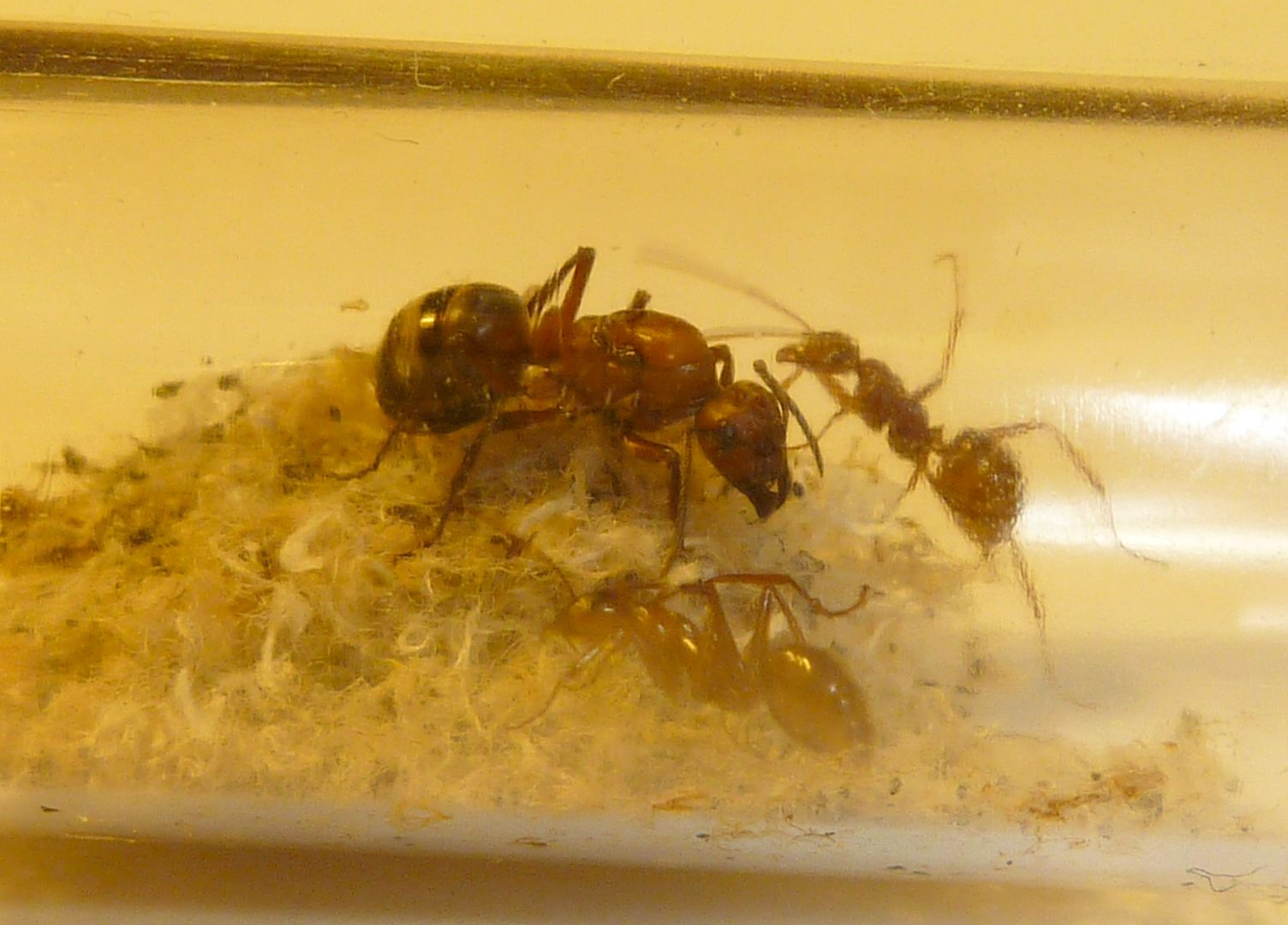Wednesday, September 28, 2011
Buckeye Butterfly Video
I took this video yesterday afternoon.
Labels:
Aster,
Butterflies,
Lepidoptera,
Video
Tuesday, September 27, 2011
Buckeye Butterflies
Common Buckeye Butterflies, Junonia coenia, have been flying all over the garden. I see them sun bathing where they can, couples are chasing one another intending to mate, and others were setting down among the Skippers and the Bees on the New England Asters.
Their population explosion is normal for New Jersey over the summer and autumn, however neither the caterpillar nor the adult butterfly can withstand a frost. Every year they recolonize the northern part of their range.
They're likely interested in all the Plantain which is a very common weed in my yard. I also have a small patch of penstemon and in the past have grown snapdragons, both of which are also host plants. Though it's hard to justify growing host plants this far north for a butterfly that isn't hardy.
They're actually a little skittish so I was surprised it let me get this close.
Normally eyes are made to scare away birds from a potential meal. So from an evolutionary stand point more eyes is better! Maybe it's trying to mimic a gigantic spider?
I would have gotten in closer if I could but sadly it flew off shortly after this was taken.
Their population explosion is normal for New Jersey over the summer and autumn, however neither the caterpillar nor the adult butterfly can withstand a frost. Every year they recolonize the northern part of their range.
They're likely interested in all the Plantain which is a very common weed in my yard. I also have a small patch of penstemon and in the past have grown snapdragons, both of which are also host plants. Though it's hard to justify growing host plants this far north for a butterfly that isn't hardy.
They're actually a little skittish so I was surprised it let me get this close.
Normally eyes are made to scare away birds from a potential meal. So from an evolutionary stand point more eyes is better! Maybe it's trying to mimic a gigantic spider?
I would have gotten in closer if I could but sadly it flew off shortly after this was taken.
Labels:
Aster,
Butterflies,
Garden,
Lepidoptera
Sunday, September 25, 2011
Plant Buying Road Trip
On Thursday I attended a plant buying trip hosted by the Mt. Cuba Center. While at one of the nurseries I found this sight of Honeybees working some Liatris microcephala. I've always ignored this species because of how scraggly it looks. This was my first time seeing it in person though and it's reminded me of Purple Prairie Clover, Dalea purpurea. I'm curious if it's common for them to have so many shoots poking up. Liatris species grow from underground corms and slowly divide, but how fast does this happen with this species? Online photos suggest that multiple flower head stalks are typical, but how long does this take? If it takes 5 years for one corm to reach the size in the video above then is it worth buying? Questions I can't answer, but I'm curious enought that I might buy the species someday.
How was my trip?
Going on these things, I'm something of the odd man out. The general crowd of 16 was comprised of middle aged women, married couples (and or husbands willing to go with their wives) were in the minority, and then there's myself a single 27 year old male. (A friend of mine joked I was there to pick up a cougar.)
As typical for my age I only got 2 hours worth of sleep the night before. I drove an hour from New Jersey to Delaware, where the Mt. Cuba Center is located. From there I got on a bus to be driven back into New Jersey. Somehow I stayed awake but looking back I regret not sleeping.
I'd rather not promote the locations we visited simply because the first two nurseries only sell wholesale to garden centers, and the last place is too expensive to be worth mentioning.
At our first stop, we were given a tour of a nursery and shown what it takes to grow plants wholesale to be shipped out across the state and sold at your local garden center. They focused a little bit to heavily on just showing up plants but I got to see various stages of one I wanted to buy.
Bottlebrush Buckeye, Aesculus parviflora, is fought over by swallowtail butterflies when it blooms in June, through July. Almost no one locally sells it, and I was thrilled to see half a green house full of them! One year seedlings came up to my knees. Second year plants came up to my waist, and they kept getting taller and bigger as we walked farther into the greenhouse. Five Gallon pots were taller than me and if I recall right only take 3 or 4 years to grow that big. In the wild this shrub can get to be 15' tall and form its own groves in full shade to full sun. Hopefully this isn't that big of a weed as I bought one.
Where our tour started going down hill was when we walked by the areas devoted to Butterfly Bush. To my dismay there's no shortage of these in the world but they were at least covered with Monarch butterflies.
Location two was an old dairy farm converted into the nursery trade, and run by the current generation of owners. We were served lunch in an old colonial farmhouse original to the building. Today it's used for weddings and easy to see why. The place is as authentically rustic as they come. The living room wreaked of smoke from decades of wood burning fires keeping the family warm.
What we were served for lunch scared me a little as I'd never had... uhhh, Is that a Tuna Fish Pizza? Taking my first bite I found that I was wrong on the tuna fish and completely in love with it enough to ask the cook for the recipe. The chef was a heavy set, elderly women, who'd probably worked hard every day of her life. She was a sweet old thing and I got the idea she was related somehow to the owner but I never thought to ask. Returning from the kitchen, she handed me a photo copied page for "Tomato, Basil and Cheese Tart" she'd taken from her grandmother's cook book, which dated back to the 1800's. You could somehow taste the decades in the recipe; people just don't cook this kind of food anymore. I would be thrilled to eat this at any wedding.
After lunch we headed out to the fields where armies of Rhododendrons were lined up in formation waiting to be shipped out. We got another brief lessen on how the nursery business works. Cultivars are maintained by cuttings taken in the spring and allowed to root in flats for the next two years. Year three they're finally upgraded to small 1 gallon pots and kept there for another two years, before being upgraded again to a 3 gallon. It takes 5 years for each Rhododendron to hit the market. Christmas trees take 7!
Whole sale prices for some of these cultivars varied from $20 to $25. I'm not sure why at all. Some of these varieties are sold at the last nursery we were going to visit for regular mark up so it was best to get our shopping done here. I've been paying attention to one cultivar in particular which is marked up to $70! Rhododendron 'millie mac' which is very unique looking and pretty, for whatever reason, has been randomly picked for price gouging! Why $70? The whole sale nursery doesn't favor this one cultivar at all, and there's no shortage of it either! Every green house had two types of plant growing in them. Rhododendron 'millie mac' is simply a name on a list to the wholesaler but at the garden center they sell their stock to it's suddenly put on a pedestal simply because they can.
The trip ended pretty much after the last nursery. We road the bus all the way back to Delaware, making my total time spent on a bus close to 7 hours for the day. The truck hauling everyone's plants was 40 minutes late showing up. And it was another hour for me to drive home.
I ate dinner and attempted to watch a TV show before going to bed. I found myself in one of the oddest states of mind I've ever been in. I started passing out in a series of cat naps without realizing it. I'd blink my eyes and suddenly there'd be a different show on the TV, and it took three times before I realized it was happening.
I had fun but I'm not sure buying plants on a bus full of strangers is the best way to go about it.
Wednesday, September 21, 2011
Last Monarch Released and Plans for Next Year
It's very important to introduce your young Monarchs to the arts before releasing them into the wild.
Well the summer is pretty much over and I was only able to raise 5 Monarchs from caterpillar to adult. Apparently I could have raised a lot more of them if I used a different method. Basically I was only going after the caterpillars who were a week to days away from forming a chrysalis. Apparently you can collect them as early as the egg stage, I didn't do that because I believed fresh milkweed would be better for them.
A friend of mine said they released at least 40 this year by collecting swatches of milkweed leaves that had eggs on them. The interruption of their flow of sap makes the milkweed safer for young caterpillars to eat starting out. But they said still 1 in 10 caterpillars die their first day, which is still better than out in the wild where 1 in 3 die their first day. Each generation needs to be kept in it's own container, adult caterpillars will eat Monarch eggs so there's no adding to the same container.
I don't know the details on how many leaves per caterpillar are needed each day but this method sounds like it's better than what I was trying. Out in the wild birds and spiders regularly make a meal out of the caterpillars, even if it means spitting them out shortly after.
Well the summer is pretty much over and I was only able to raise 5 Monarchs from caterpillar to adult. Apparently I could have raised a lot more of them if I used a different method. Basically I was only going after the caterpillars who were a week to days away from forming a chrysalis. Apparently you can collect them as early as the egg stage, I didn't do that because I believed fresh milkweed would be better for them.
A friend of mine said they released at least 40 this year by collecting swatches of milkweed leaves that had eggs on them. The interruption of their flow of sap makes the milkweed safer for young caterpillars to eat starting out. But they said still 1 in 10 caterpillars die their first day, which is still better than out in the wild where 1 in 3 die their first day. Each generation needs to be kept in it's own container, adult caterpillars will eat Monarch eggs so there's no adding to the same container.
I don't know the details on how many leaves per caterpillar are needed each day but this method sounds like it's better than what I was trying. Out in the wild birds and spiders regularly make a meal out of the caterpillars, even if it means spitting them out shortly after.
Labels:
Art,
Caterpillar,
Monarch,
Painting
Sunday, September 18, 2011
A Monarch Hatches
This misleading silhouette is actually a Monarch butterfly emerging from it's chrysalis. It's always hard to imaging how the butterfly fits in the thing in the first place. From what I can gather, immediately after hatching they instantly inflate, while expelling excess liquids and frass over the next hour or so.
From another angle we see something more resembling the butterfly so beloved. They hang upside down in order to inflate their wings so they can harden properly. Their wings are otherwise limp and similar to a small swatch of silk someone might use to clean their glasses with. It's very unnatural to observe their wings when they're limp like that.
Within a few minutes they've expanded quite a bit, but are still in need of stiffening up.
After the first hour or so, they're capable of flying a short distance but benefit from more time. If they do fly it's usually to escape a predator or to get a better spot perched higher on a tree.
Pictured above were all males which are slightly smaller than the females.
Here is a female. Her wingspan is slightly greater and she lack two dark marks on the rear wings (not visible in this photo).
Weather they are male or female there's just no beating that color. The Monarch butterfly is the color orange of our autumn, and the world is richer for it's existance.
From another angle we see something more resembling the butterfly so beloved. They hang upside down in order to inflate their wings so they can harden properly. Their wings are otherwise limp and similar to a small swatch of silk someone might use to clean their glasses with. It's very unnatural to observe their wings when they're limp like that.
Within a few minutes they've expanded quite a bit, but are still in need of stiffening up.
After the first hour or so, they're capable of flying a short distance but benefit from more time. If they do fly it's usually to escape a predator or to get a better spot perched higher on a tree.
Pictured above were all males which are slightly smaller than the females.
Here is a female. Her wingspan is slightly greater and she lack two dark marks on the rear wings (not visible in this photo).
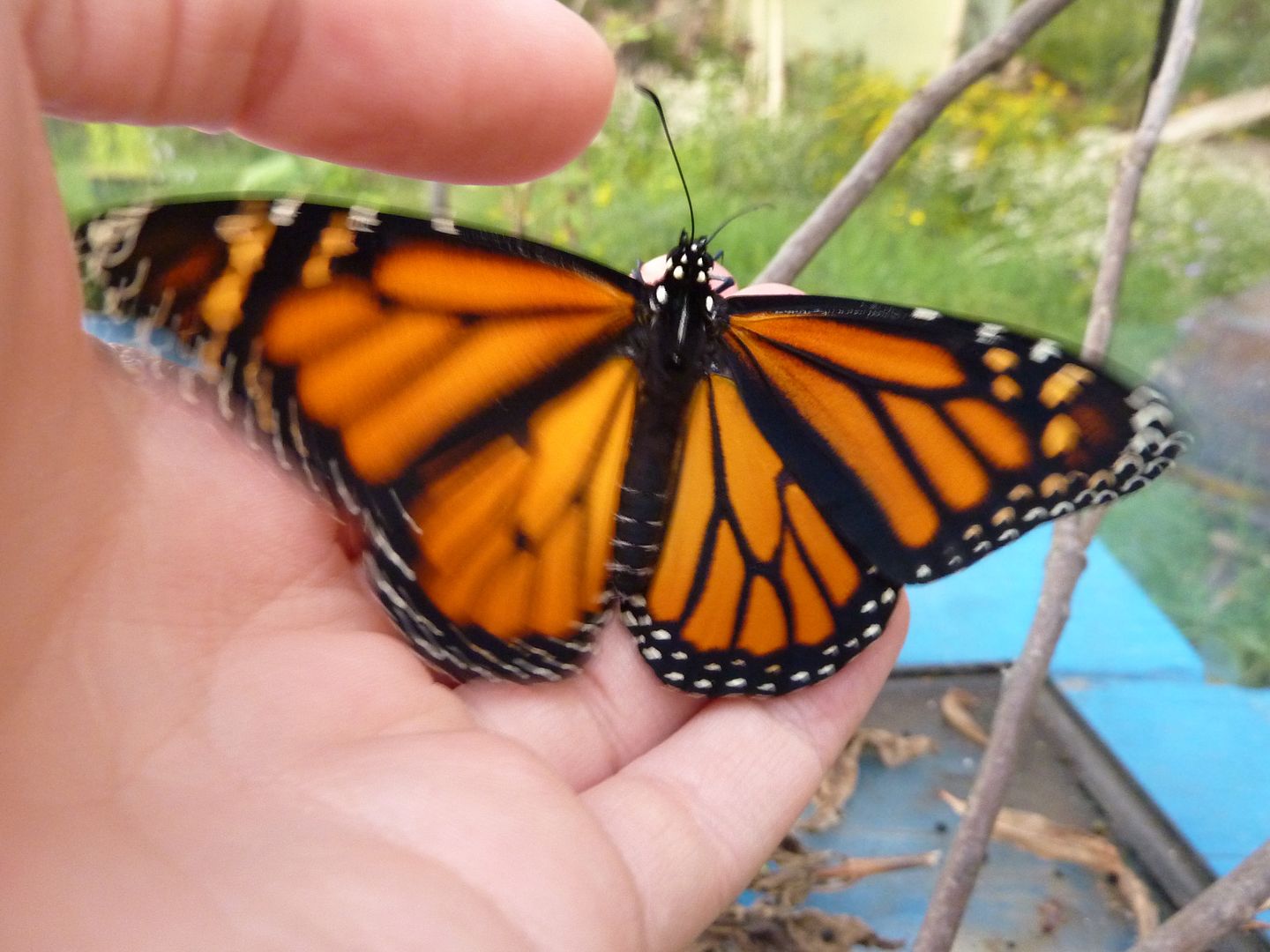 |
| Monarch Female: Note the lack of two dark marks on the rear wings. |
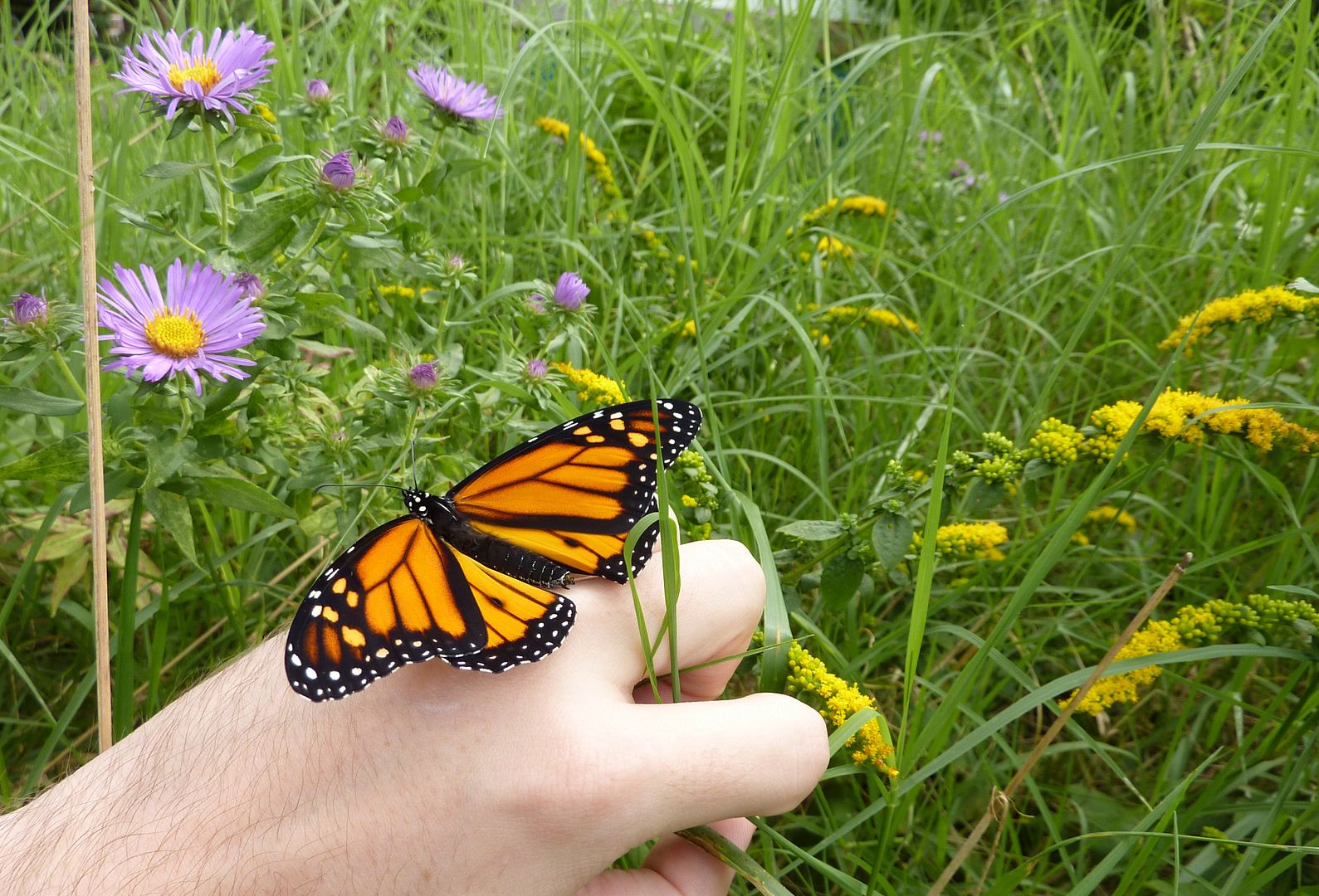 |
| Monarch Male: Note the two dark marks on the rear wings. Typically these line up with the nearest dark vane. |
Friday, September 16, 2011
Southern Blue Monkshood, Aconitum uncinatum
I planted 3 plugs in the spring of Southern Blue Monkshood, Aconitum uncinatum. One kept getting dug up by the wildlife and died. Another is still alive but got nibbled off at the tip, so it's stopped growing. The last impresses me the most though as it's only reach 1' tall and decided to flower.
The flowers have slightly blued up since this photo. Technically this plant is a vine but I'd described it more as a bramble. I've seen mature plants at the Mt. Cuba Center. They send out lots of soft canes that spread and climb up other plants when they can. They don't get taller or spread more than 5' feet before flowering in the late summer. Each winter they die back to the ground, making this a well behaved vine. They grow in partial sun to full shade, like it a little on the wet side I think, and I've seen Monarch butterflies visit the flowers along with bees and hover flies.
Nonnative Monkshoods are more commonly sold. They're not vines or brambles though, but rather up right perennials on par with a snapdragon or lupine. It seems our natives are the only ones that grow to be semi-vines. They're a real treat to have because the foliage stays hidden for most of the year. Our natives are not widely sold but I got mine from Toadshade Wildflower Farm, direct link.
The flowers have slightly blued up since this photo. Technically this plant is a vine but I'd described it more as a bramble. I've seen mature plants at the Mt. Cuba Center. They send out lots of soft canes that spread and climb up other plants when they can. They don't get taller or spread more than 5' feet before flowering in the late summer. Each winter they die back to the ground, making this a well behaved vine. They grow in partial sun to full shade, like it a little on the wet side I think, and I've seen Monarch butterflies visit the flowers along with bees and hover flies.
Nonnative Monkshoods are more commonly sold. They're not vines or brambles though, but rather up right perennials on par with a snapdragon or lupine. It seems our natives are the only ones that grow to be semi-vines. They're a real treat to have because the foliage stays hidden for most of the year. Our natives are not widely sold but I got mine from Toadshade Wildflower Farm, direct link.
Tuesday, September 13, 2011
Planned Reading: "Rambunctious Garden" by Emma Marris
This is my current interest. I'll be buying their book hopefully by the end of the month. The author, Emma Marris, was on KUOW's Greenday Gardening Panel earlier today; here is the direct link. Basically she takes an ecologist's point of view to gardening (and managing wildlife habitats?). She points out calling something native simply because it was growing at date X is arbitrary when we consider the millions of years of history before. Native Americans starting wildfires, driving large mammals to extinction, glaciers rampaging down the continent, etc...
Normally I'd brush this off as a boo hoo argument by the ornamental industry who have been pushing nonnatives on the average home owner since the dawn of time. However, Emma makes some surprisingly well thought out arguments. The problem, for me at least, is she sounds both smart or stupid at the same time. She encourages people to plant natives but also non-historically-native plants as long as they help pursuer a certain goal (look nice, birds, butterflies, pollinators, bugs, other wildlife). And this can be a stupid idea if someone has no idea what's native and what's not. The ornamental industry and most nurseries certainly don't make it easy to tell the difference. So the real beneficial gardens are only going to come from the people who've researched the topic of native plant. This movement could greatly benefit from a little education which might well be in her book, but this also contradicts her earlier point of just planting whatever helps you reach your goal. See what I mean by smart and stupid at the same time, for lack of a better term?
Her point of view seems to be so broad that it's almost impossible for her to be wrong on the top of what's right to plant where. Hopefully her book has lots of substance and personal touches as I'm looking forward to reading it sometime in the near future.
Labels:
Book
Saturday, September 10, 2011
My Backyard Meadow Tour
I figured I'd do a video tour of this year's meadow garden. These were all plugs so most of the spring and summer flowering species didn't flower well. All the autumn bloomers are doing great though. I plan to at some point weed out the grasses. Mowing will be done sometime next march. And hopefully everything that didn't bloom this year will come back in force next spring.
Friday, September 9, 2011
How I Saved A Plant
A few years ago I noticed lots of yellow flowers growing along the hill behind my place of work. I'd passed it off as goldenrod until I finally walked up there and found these wonderful Coreopsis flowers. That is, I believe they're a Coreopsis of some sort. I've never identified them to species.
A year later they weren't really around, but the year after that they came back in force. What was odd though is the flowers now all had this red ring in the middle going around on each petal, presumably a genetic variation that skips a generation or perhaps a sign of some nutrient in the soil. Whatever the reason, it seemed like all of them had it that year.
Fast forward to just two years ago I learn they're going to bulldoze the hill to expand the strip mall. The concept of native plant salvaging was in my head at the time, so I got my shovel, went to the hillside and potted up a few Coreopsis plants. Into the garden they went... where sadly they didn't come back the next year.
But then I find this growing behind our shed right next to the garden I'd planted them in. It's in a very disturbed location. I had piles of wood there for years and only recently removed it to reveal bare soil. I'm certain this must be the same species as what was growing along the hillside. From what I can tell these plants must be short lives and run on some kind of biannual cycle. The thing is the adult plants were about 4' tall and this is only a few inches. Perhaps they flower the first year at a short height and come back with more vigor on the second year.
Perhaps it would have been better if I'd collected seeds? Thinking back I wonder if seeds didn't germinate better on slopes where people often sledded in the winter. Hmmm.
A year later they weren't really around, but the year after that they came back in force. What was odd though is the flowers now all had this red ring in the middle going around on each petal, presumably a genetic variation that skips a generation or perhaps a sign of some nutrient in the soil. Whatever the reason, it seemed like all of them had it that year.
Fast forward to just two years ago I learn they're going to bulldoze the hill to expand the strip mall. The concept of native plant salvaging was in my head at the time, so I got my shovel, went to the hillside and potted up a few Coreopsis plants. Into the garden they went... where sadly they didn't come back the next year.
But then I find this growing behind our shed right next to the garden I'd planted them in. It's in a very disturbed location. I had piles of wood there for years and only recently removed it to reveal bare soil. I'm certain this must be the same species as what was growing along the hillside. From what I can tell these plants must be short lives and run on some kind of biannual cycle. The thing is the adult plants were about 4' tall and this is only a few inches. Perhaps they flower the first year at a short height and come back with more vigor on the second year.
Perhaps it would have been better if I'd collected seeds? Thinking back I wonder if seeds didn't germinate better on slopes where people often sledded in the winter. Hmmm.
Tuesday, September 6, 2011
Monarch Metamorphosis
This was more time consuming to photograph than I thought it would be. What I've learned after 6 caterpillars over the past month is weather they're hatching from a chrysalis (left) or about to begin one (right), all major changes take place during the daylight hours.
When ready to morph into a chrysalis the caterpillar will hang upside down for a while and form the letter J (see above). The green lines toward the head tell you they're going to morph, but if it's already getting dark out this isn't going to happen until bright and early the next morning.
The initial change is incredibly quick to start out. I woke up very early this morning to find a caterpillar hanging in the J shape as it had been the night before. Sometime in the next 10 minutes I stopped watching it had turned into this! I believe it shed it's skin off revealing the bright green flesh beneath.
The head is towards the bottom where several yellow-gold dots are forming. The wings also form now and their development will slowly cover most of the body. What remains of it's suction-cup feet dissolve away. Also note the more solid white line in the middle of the body. We'll follow it's progress farther on.
The next hour seems mostly devoted to expanding the wings, and forcing most of the body fat (mass?) towards the top. This is done through a series of wiggles. That white line slowly makes it's way higher and higher as this goes on.
Slowly all the pieces come together and solidify their final resting place.
Note how high up the white line has risen. That was the half way mark in the caterpillar's body when this began. I can only imagine how inside-out the contents of this insect must be in there. It's has reached it's final shape but there's still some smoothing out to do.
This is what they look like two hours in. The chrysalis becomes more opaque over time and turns a beautiful emerald green color with gold trim and spots.
This image is from last year.
I feel like there should be a trend of women gluing these to necklaces to wear as jewelry for the brief time that they look this pretty.
10 to 14 days later they hatch. This also happens in the early morning, but they'll turn transparent the day before.
When ready to morph into a chrysalis the caterpillar will hang upside down for a while and form the letter J (see above). The green lines toward the head tell you they're going to morph, but if it's already getting dark out this isn't going to happen until bright and early the next morning.
The initial change is incredibly quick to start out. I woke up very early this morning to find a caterpillar hanging in the J shape as it had been the night before. Sometime in the next 10 minutes I stopped watching it had turned into this! I believe it shed it's skin off revealing the bright green flesh beneath.
The head is towards the bottom where several yellow-gold dots are forming. The wings also form now and their development will slowly cover most of the body. What remains of it's suction-cup feet dissolve away. Also note the more solid white line in the middle of the body. We'll follow it's progress farther on.
The next hour seems mostly devoted to expanding the wings, and forcing most of the body fat (mass?) towards the top. This is done through a series of wiggles. That white line slowly makes it's way higher and higher as this goes on.
Slowly all the pieces come together and solidify their final resting place.
Note how high up the white line has risen. That was the half way mark in the caterpillar's body when this began. I can only imagine how inside-out the contents of this insect must be in there. It's has reached it's final shape but there's still some smoothing out to do.
This is what they look like two hours in. The chrysalis becomes more opaque over time and turns a beautiful emerald green color with gold trim and spots.
This image is from last year.
I feel like there should be a trend of women gluing these to necklaces to wear as jewelry for the brief time that they look this pretty.
10 to 14 days later they hatch. This also happens in the early morning, but they'll turn transparent the day before.
Saturday, September 3, 2011
Meadow Project: September
Well it's September and my little meadow's fall blooming species have started to become very showy. Everything was started here as a bare root plug. Most of the spring and summer blooming species didn't flower at all, some even went dormant or died. Hopefully they'll all be back in force next year.
Tall Coreopsis, Coreopsis tripteris, is about 3' tall and topped with lots of flowers. Not bad for two bare roots that cost $5 each. I could see going nuts with this plant in the coming years. When they become better established I'm sure they'll reach that 5' to 8' tall I read on the internet.
Showy Goldenrod, Solidago speciosa. This plant gets it's name for being showy. The internet does a better job of showing that off than my blog though. All four of my plants fell over and are sort of slinking along the ground. The orientation of the flowers is somewhat more uniform than on other Solidago's also the really tiny flower petals are slightly larger too, making them look more brightly yellow.
There are a few Asters popping open now too but nothing showy enough to take a picture of.
The butterfly weed, Asclepias tuberosa, flowered well and has now gone to seed. Over the summer that awful grass has come back in force, I'll need to start weeding it out again.
The Ozark Coneflowers, Echinacea paradoxa, have particularly neat leaf clusters. They're nowhere near native to New Jersey but frankly nothing in Echinacea is anyhow. What drew me to it was it's yellow flowers, without having to be a cultivar.
I need to weed out some grass but I'm overall happy with what's out there.
Tall Coreopsis, Coreopsis tripteris, is about 3' tall and topped with lots of flowers. Not bad for two bare roots that cost $5 each. I could see going nuts with this plant in the coming years. When they become better established I'm sure they'll reach that 5' to 8' tall I read on the internet.
Showy Goldenrod, Solidago speciosa. This plant gets it's name for being showy. The internet does a better job of showing that off than my blog though. All four of my plants fell over and are sort of slinking along the ground. The orientation of the flowers is somewhat more uniform than on other Solidago's also the really tiny flower petals are slightly larger too, making them look more brightly yellow.
There are a few Asters popping open now too but nothing showy enough to take a picture of.
The butterfly weed, Asclepias tuberosa, flowered well and has now gone to seed. Over the summer that awful grass has come back in force, I'll need to start weeding it out again.
The Ozark Coneflowers, Echinacea paradoxa, have particularly neat leaf clusters. They're nowhere near native to New Jersey but frankly nothing in Echinacea is anyhow. What drew me to it was it's yellow flowers, without having to be a cultivar.
I need to weed out some grass but I'm overall happy with what's out there.
Friday, September 2, 2011
A Monarch is Born
It's almost a shame that Monarchs hatch out of their chrysalis. They're a really pretty emerald green with gold trim.
Slowly as they start to hatch these colors fade away, slowly revealing the true prize within.
This most recent photo was how it looked this morning. I said to myself, "I'm going to take this to work with me and photograph it there." So I show up and I'm waiting to be let inside. I take a peak down in the container and find it's already hatched and is walking about. The wings are as limp and floppy as a silk handkerchief. Through the course of the day he (it had two dark spots on the middle of the rear wings) inflated and dried his wings. Work is a little bit more dimly lit for my pictures to come out good so there are no photos of this.
Once I got home that afternoon I released him out on the Showy Milkweed in the small meadow garden.
The plant has unfortunately fallen over, but that didn't stop the Monarch at all.
Currently I have two more chrysalises in a screened in cage and several more caterpillars out on the plants. I'll likely have more images of Monarchs in the coming months.
Slowly as they start to hatch these colors fade away, slowly revealing the true prize within.
This most recent photo was how it looked this morning. I said to myself, "I'm going to take this to work with me and photograph it there." So I show up and I'm waiting to be let inside. I take a peak down in the container and find it's already hatched and is walking about. The wings are as limp and floppy as a silk handkerchief. Through the course of the day he (it had two dark spots on the middle of the rear wings) inflated and dried his wings. Work is a little bit more dimly lit for my pictures to come out good so there are no photos of this.
Once I got home that afternoon I released him out on the Showy Milkweed in the small meadow garden.
The plant has unfortunately fallen over, but that didn't stop the Monarch at all.
Currently I have two more chrysalises in a screened in cage and several more caterpillars out on the plants. I'll likely have more images of Monarchs in the coming months.
Ant Chat Episode 35: My Formica pergandei Colony
So I've decided to do another episode. Ants during the summer really take a break, which is a shame because that's when ratings for my show go through the roof. Now that we've had a few hurricanes, err umm, cold spells, more ants are becoming active and I'll be able to post more outdoor things hopefully.
Some images of my Formica pergandei colony and host workers.
Subscribe to:
Posts (Atom)

